The Little Sister of Fribourg
DIDIER HEUMANN, ANDREAS PAPASAVVAS

We divided the course into several sections to make it easier to see. For each section, the maps show the course, the slopes found on the course, and the state of the roads. The courses were drawn on the “Wikilocs” platform. Today, it is no longer necessary to walk around with detailed maps in your pocket or bag. If you have a mobile phone or tablet, you can easily follow routes live.
For this stage, here is the link:
https://fr.wikiloc.com/itineraires-randonnee/de-fribourg-a-romont-par-la-via-jacobi-4-67290147
It is obviously not the case for all pilgrims to be comfortable with reading GPS and routes on a laptop, and there are still many places without an Internet connection. Therefore, you can find a book on Amazon that deals with this course. Click on the title of the book to open Amazon.
If you only want to consult lodging of the stage, go directly to the bottom of the page.
Nestled within the picturesque canton of Fribourg, where each city has its own story to tell, lies Romont, a true medieval gem emerging as the beloved little sister of the majestic city of Fribourg. Its name, derived from the Latin Rotundus Mons, alludes to the roundness of its hills. With its modest population of 5,000 souls, it reveals its charms through streets such as Grand Rue or Rue des Châteaux. Dominated by the remnants of the castle and towers that once encircled its walls, Romont presents a silhouette of timeless elegance. The 1,500 meters of ramparts that enclose it, once crowned with roofs, now stand as guardians of memories, preserving the essence of this medieval town. Only four towers still proudly stand, silent witnesses of a tumultuous past where battlements, arrow slits, and machicolations offer striking panoramas of the surroundings, like windows open to the passage of time.
The canton of Fribourg, in turn, first reveals itself as an agricultural stronghold where more than 60% of the territory is dedicated to meadows. Across its 4,000 farms, meadows and pastures hold a place of honor, devoted mainly to dairy farming, a generous provider of milk, butter, cream, and cheese, epitomized by the famous double cream and Gruyère cheese. Among the 550,000 dairy cows in Switzerland, four breeds vie for attention, yet nowhere else can one find the purity of the famous Hérens cow.
- The majestic Swiss Fleckvieh dominates 48% of the livestock. Originating from the Bernese Oberland, it is the result of a clever mix between local varieties and the robust, now nearly extinct, Simmental spotted breed. Its successful union with the Canadian Red Holstein has increased milk production while preserving meat quality.
- The Brown Swiss breed, proud representative of 37% of the livestock, originated in the heart of Central and Eastern Switzerland. Through judicious crossbreeding with the American Brown Swiss breed, it has managed to increase its milk yield, although the original Swiss breed has almost entirely disappeared.
- The famous Black Holstein, in turn, makes up 13% of the livestock. A product of crossbreeding between Fribourg cows and Black and White Holsteins, it stands out for its prodigious milk-producing capacity, earning it the title of the most widespread dairy breed in the world.
- Lastly, the rare Hérens black breed, a living emblem representing less than 1% of the livestock, is a true curiosity. But do not underestimate these animals in the canton of Valais, where their magnificent horns serve as weapons in epic duels, testifying to an ancestral strength.
Difficulty level: The day’s elevation changes, ranging between +488 meters and -357 meters, offer a stage of over 25 kilometers with exquisite moderation. The steep slopes, both uphill and downhill, are reserved for the beginning of the route, where the valley and gorges of the Glâne assert their majesty, or at the midpoint, when the route rejoins the banks of the Glâne near Posat. The rest of the journey resembles a walk, an invitation to contemplation.

State of the Via Jacobi: Today, the route unfolds primarily on roads:
- Paved roads: 17.4 km
- Dirt roads: 8.9 km
Sometimes, for reasons of logistics or housing possibilities, these stages mix routes operated on different days, having passed several times on Via Podiensis. From then on, the skies, the rain, or the seasons can vary. But, generally this is not the case, and in fact this does not change the description of the course.
It is very difficult to specify with certainty the incline of the slopes, whatever the system you use.
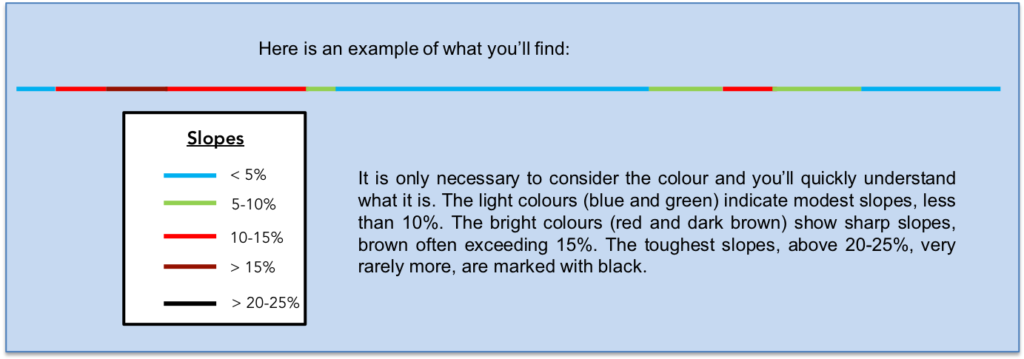
For those seeking “true elevations” and enthusiasts of genuine altimetric challenges, carefully review the information on mileage at the beginning of the guide.
We have divided the route into several sections, to facilitate visibility. For each section, the maps give the route, the slopes found on the route and the state of Via Jacobi.
Section 1: The long crossing of the city of Fribourg.
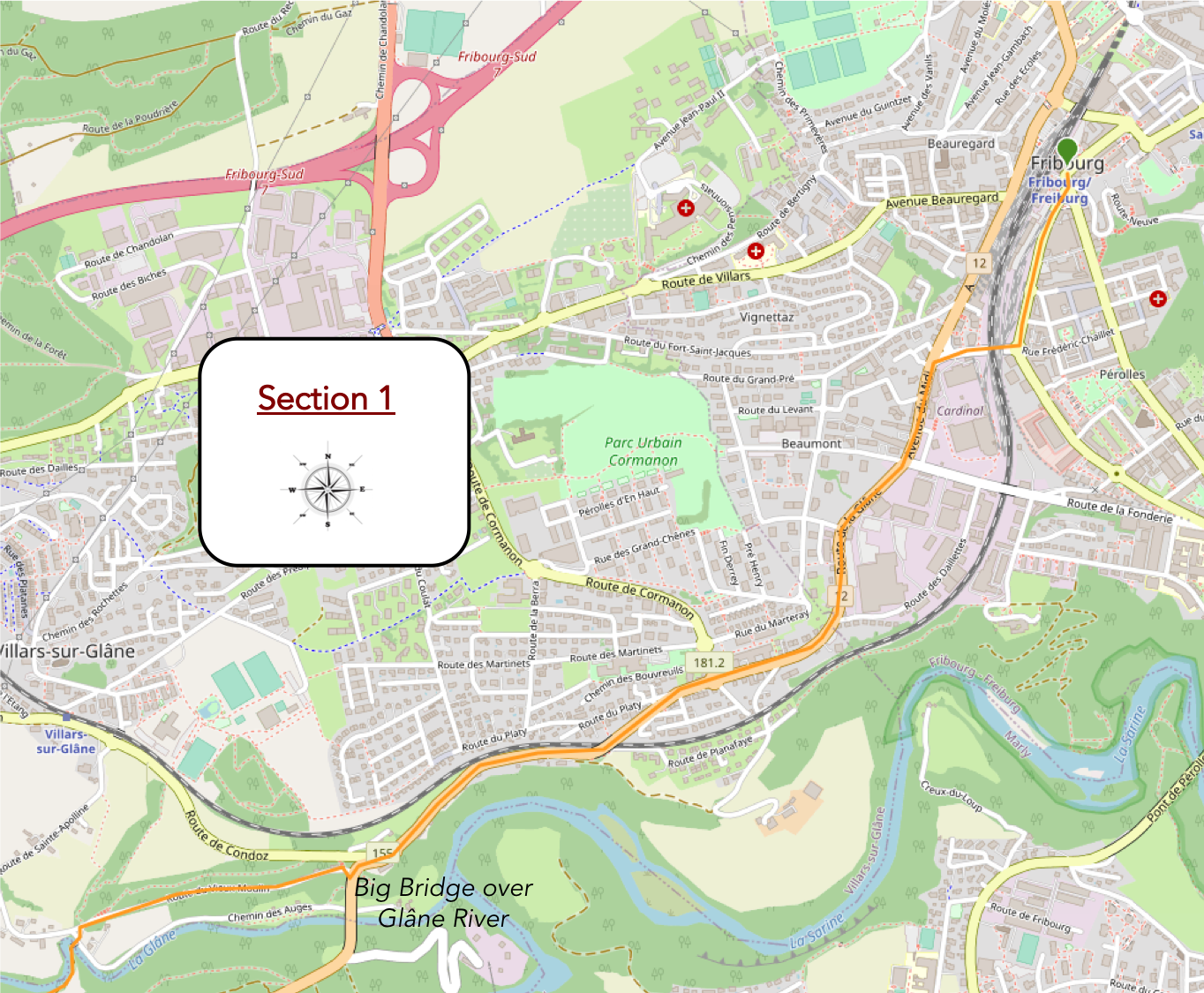
Overview of the route’s challenges: a journey without difficulty.
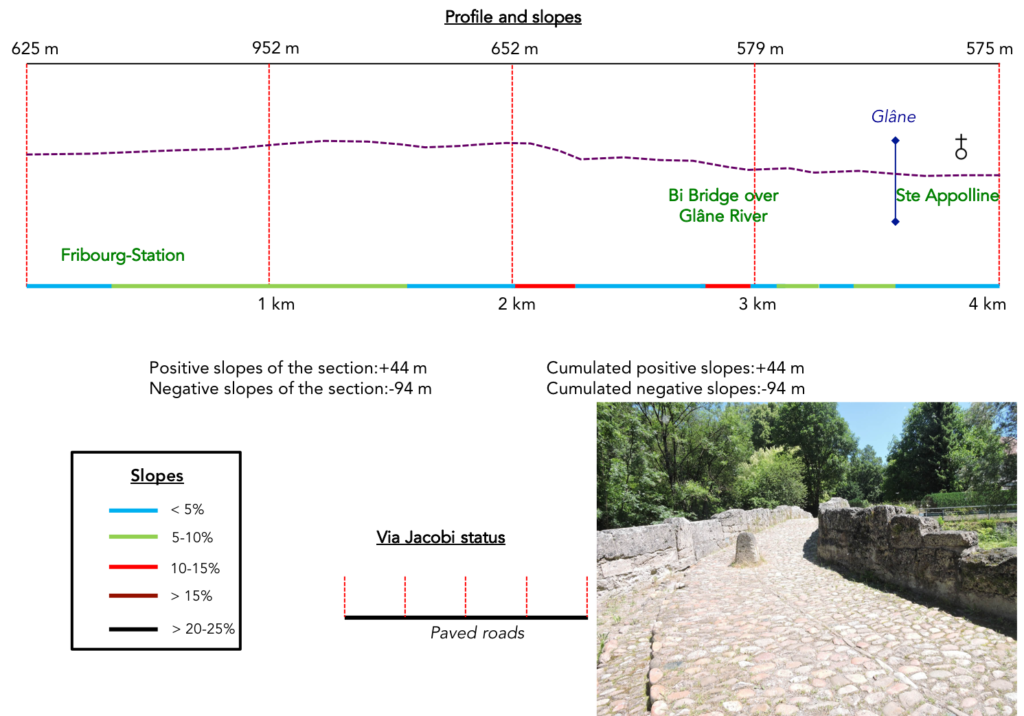
To leave the city of Fribourg and embark on the Via Jacobi, a delicate approach is required. The directions, as timid as the first light of dawn, struggle to reveal themselves. Choosing to start from the station is a wise decision. From there, take the grand Rue des Arsenaux, then, like a graceful dancer, turn right onto Passage du Cardinal. In this urban symphony, Avenue du Midi makes its presence known, extending like a ribbon of promises into the prestigious Route de la Glâne. This road, a thread between Fribourg and Bulle, unveils its charms, yet the Via Jacobi, a discreet muse, veers away lower down towards Villars-sur-Glâne. There’s no need to venture there, as, like a capricious serpent, the Via Jacobi winds through the bends, where the risk of getting lost lurks. The wise decision, therefore, is to follow Rue de la Glâne, a faithful sentinel on the sidewalk, with confident steps.

| As you move away from the station, the streets transform into living paintings, each corner revealing a piece of history. The majestic chimney of the old Cardinal brewery stands like a beacon in the urban skyline, while a nod to the region’s renowned chocolate-making tradition is presented in the form of a sculpted cow, a tasty symbol of ancestral know-how. |
 |
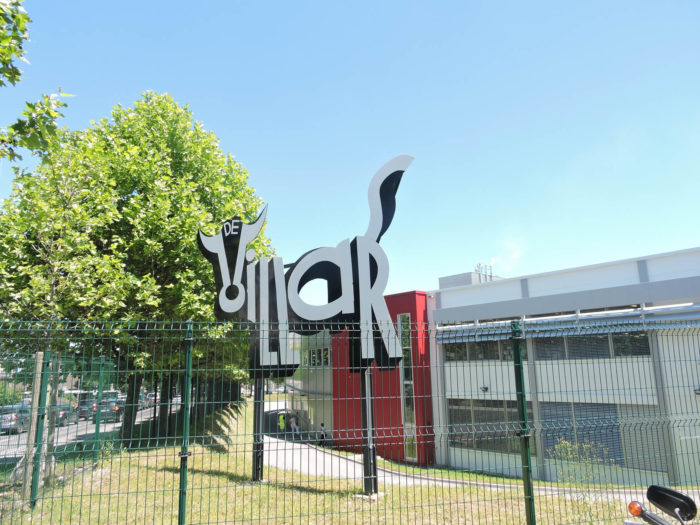 |
| Route de la Glâne, like an asphalt river, traverses the southern quarters of the city with deliberate slowness, offering travelers the changing spectacle of lives flowing by. |
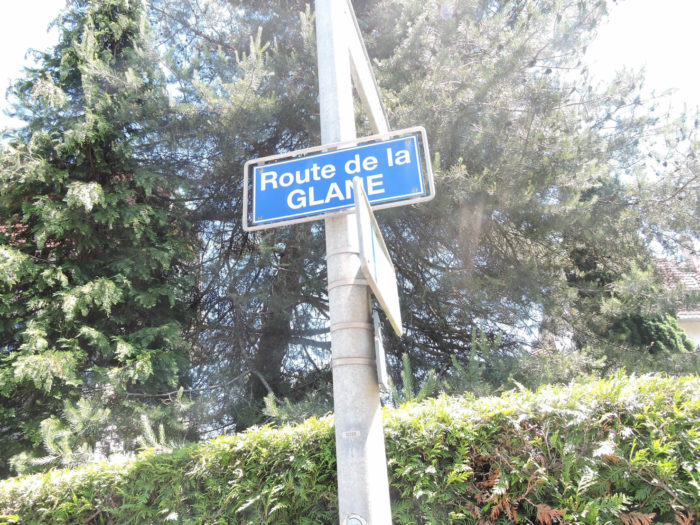 |
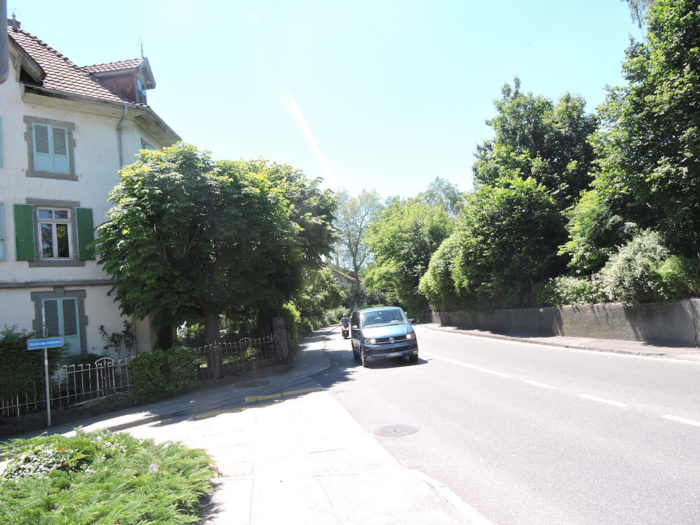 |
| Here, there are no detours or deceptive promises of stray paths. Stay on the concrete trail and let it carry you to the outskirts of the city, where the railway fades into the horizon. |
 |
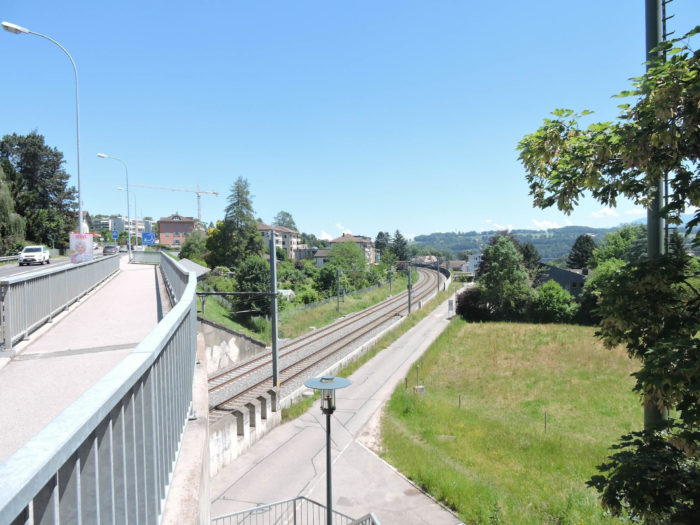 |
| Further on, Fribourg blends into the landscape, giving way to Villars-sur-Glâne without ceremony. Here, the road animates with a marked descent towards the crystalline waters of the river, marking the start of a new adventure. |
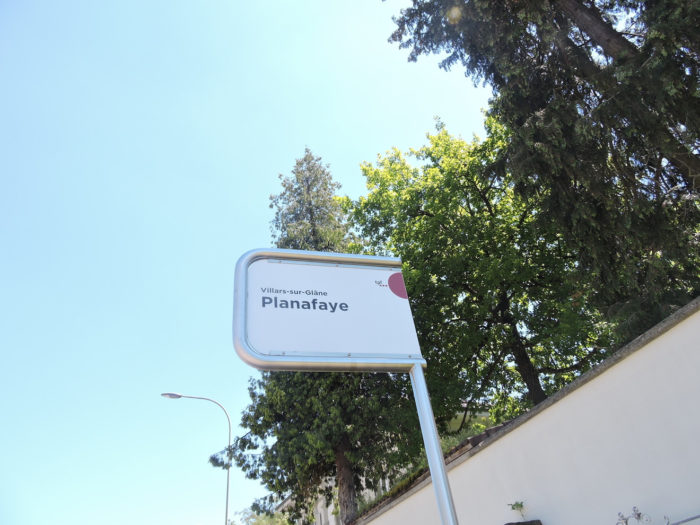 |
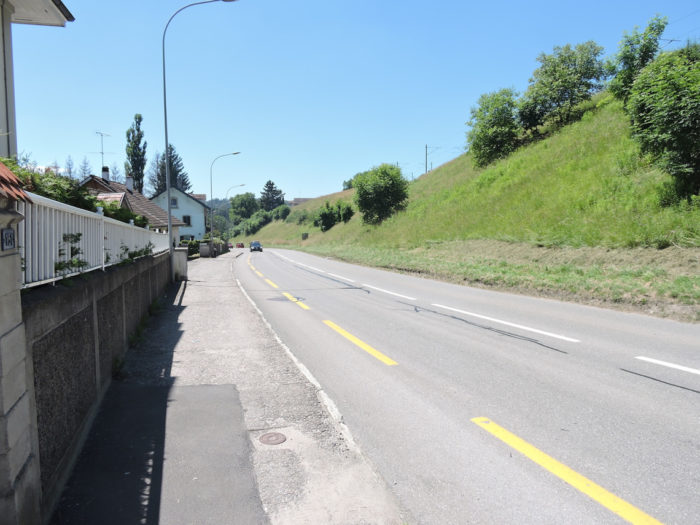 |
| At the city’s edge, an imposing bridge stands, crossing the Glâne River with immutable grace. While the RN12 escapes towards Bulle, the Via Jacobi, like a thread of Ariadne woven by divine hands, invites the discovery of more secret trails. |
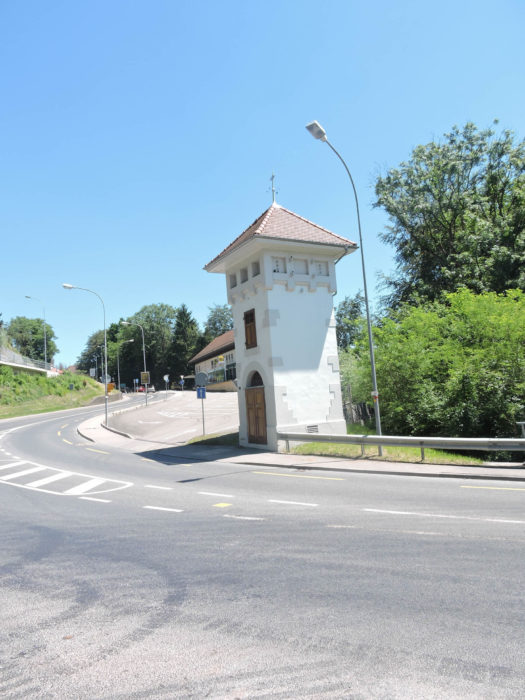 |
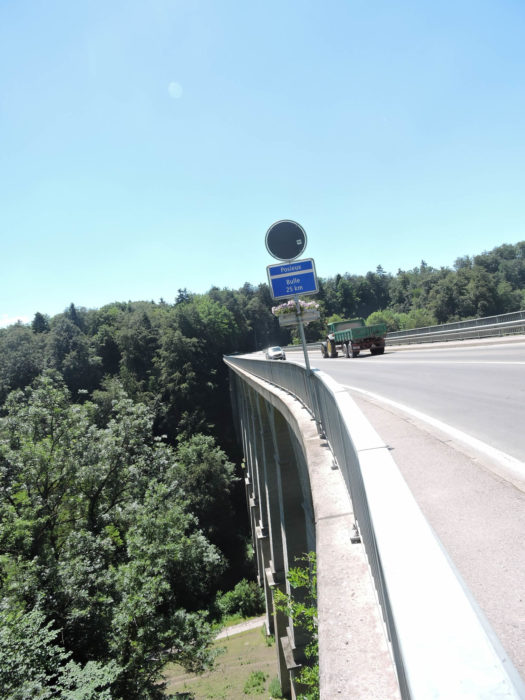 |
Near the bridge, a signpost shows a multitude of directions. Here, you must imperatively follow Via Jacobi 81, which leads to Ste Apolline and Bois de Monterban. The route descends to the right of the bridge towards the river.
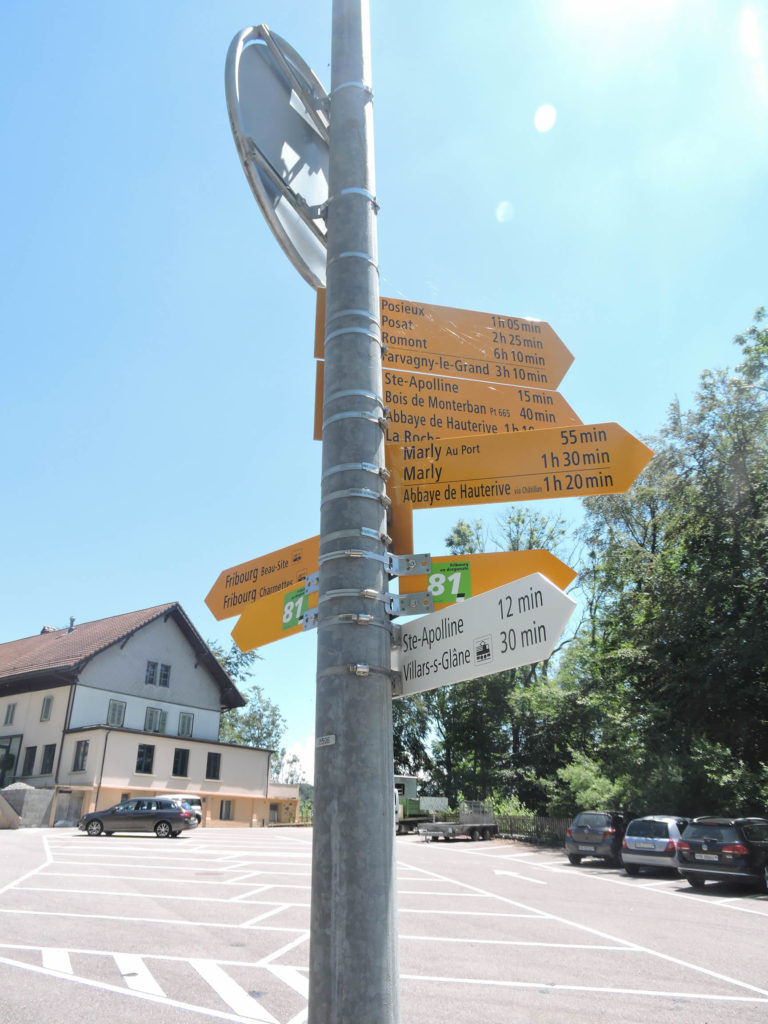
| A sidewalk snakes along the route du Vieux Moulin, guiding pilgrims’ steps towards the shimmering banks of the Glâne, where the murmurs of the water mingle with memories of yore. |
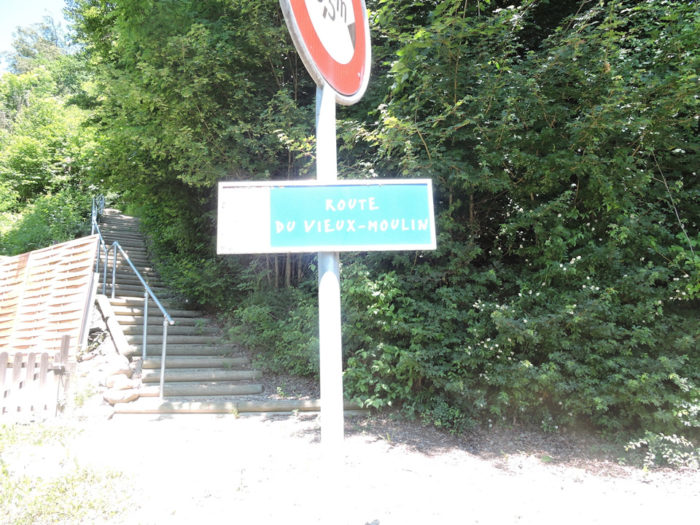 |
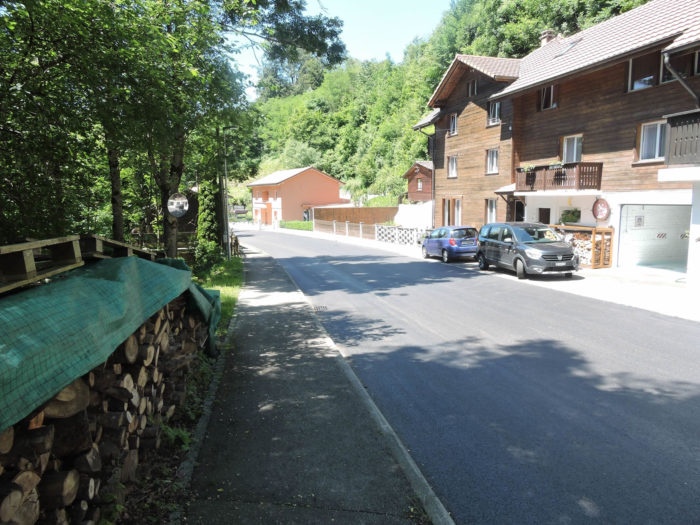 |
| In the dark woods that stand like a vegetal rampart, the atmosphere is charged with a charming aura announcing the river. |
 |
 |
At the end of this brief descent, at the crossroads, you are once again on the Camino de Santiago.

| The site, imbued with ancient magic, reveals the Glâne Bridge, a secular relic of a glorious past. A silent witness to the ages, this stone jewel, shaped by time and elements, narrates forgotten epics that have shaped the region since time immemorial. Erected in the 16th-17th century, this bridge testifies to ancestral know-how, where each stone seems to whisper a forgotten tale. Despite the ravages of time, its majesty remains, a timeless symbol of resilience and grandeur. |
 |
 |
Nearby, the chapel of Sainte Apolline stands tenderly, a silent guardian of the past’s secrets. Built in 1147, its tumultuous history still resonates through the ages, its walls impregnated with prayers and mysteries. While the winds of time have erased many traces, the spirit of the Saint, a virgin and martyr, endures, reminding believers of the strength of faith and the power of devotion. Numerous decayed teeth have been found around the building. This Saint, a virgin and martyr, was burned in Alexandria in 248, after her teeth had been pulled out. She is invoked in cases of toothache.
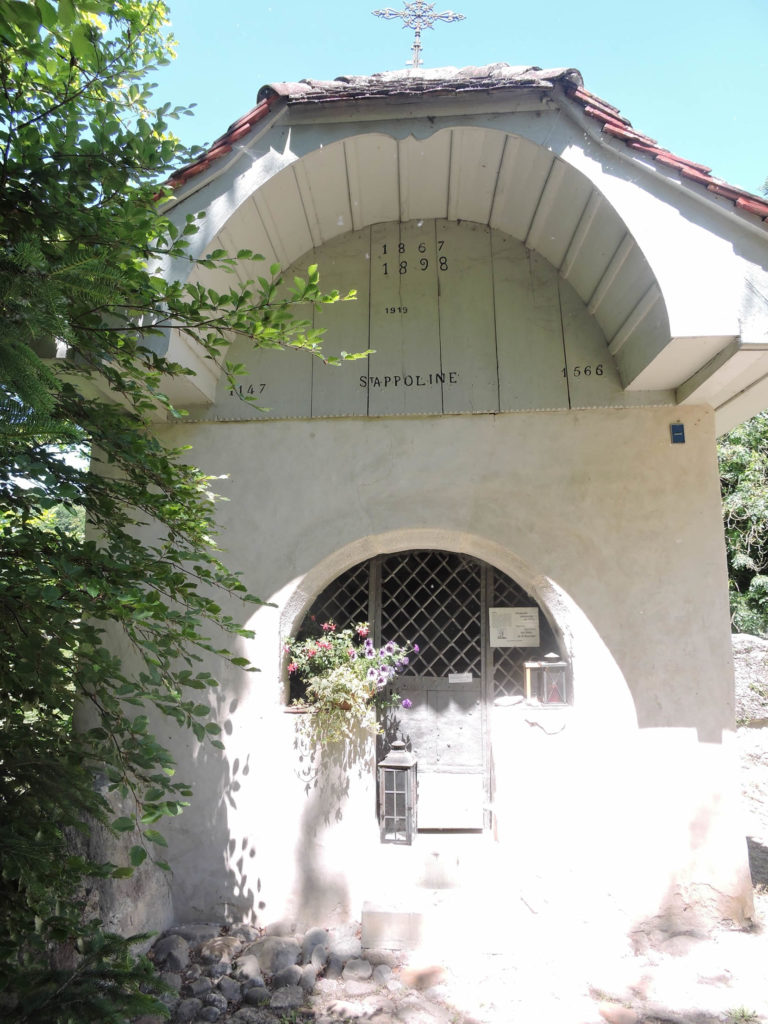
The Glâne, a watery jewel of the Canton of Fribourg, meanders through the landscapes, offering travelers a visual and auditory symphony. Throughout the journey, its glittering waters guide the steps of pilgrims, a constant reminder of nature’s fragile beauty and the journey’s permanence.
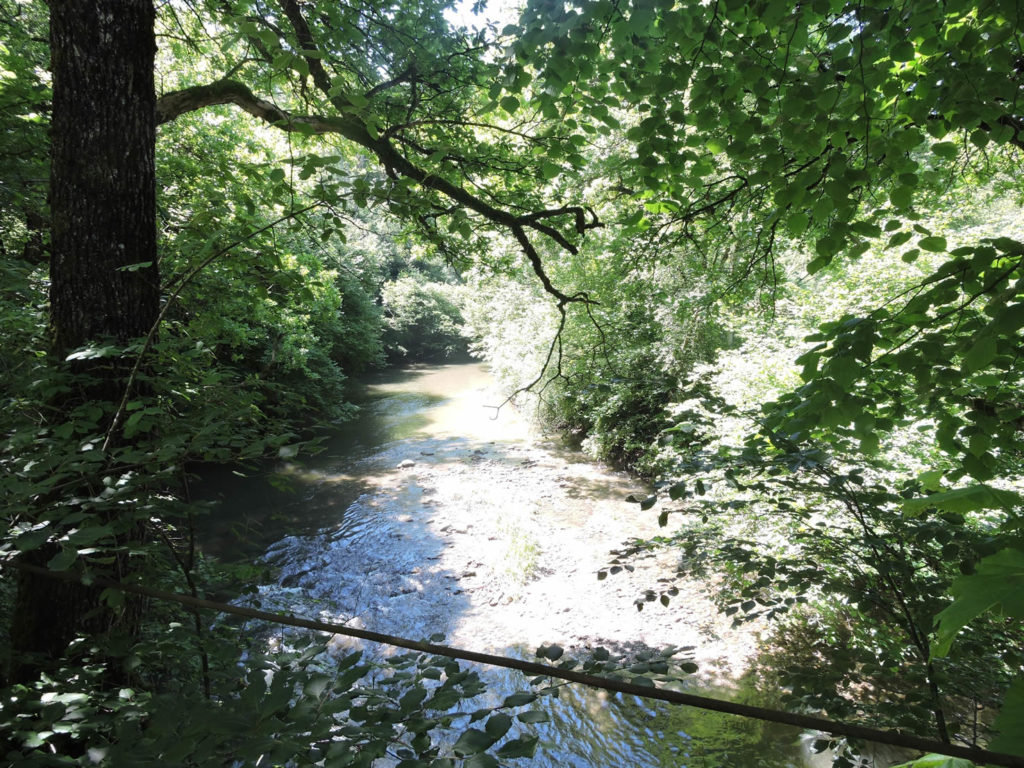
Section 2: Over hill and dale in the Fribourg countryside.
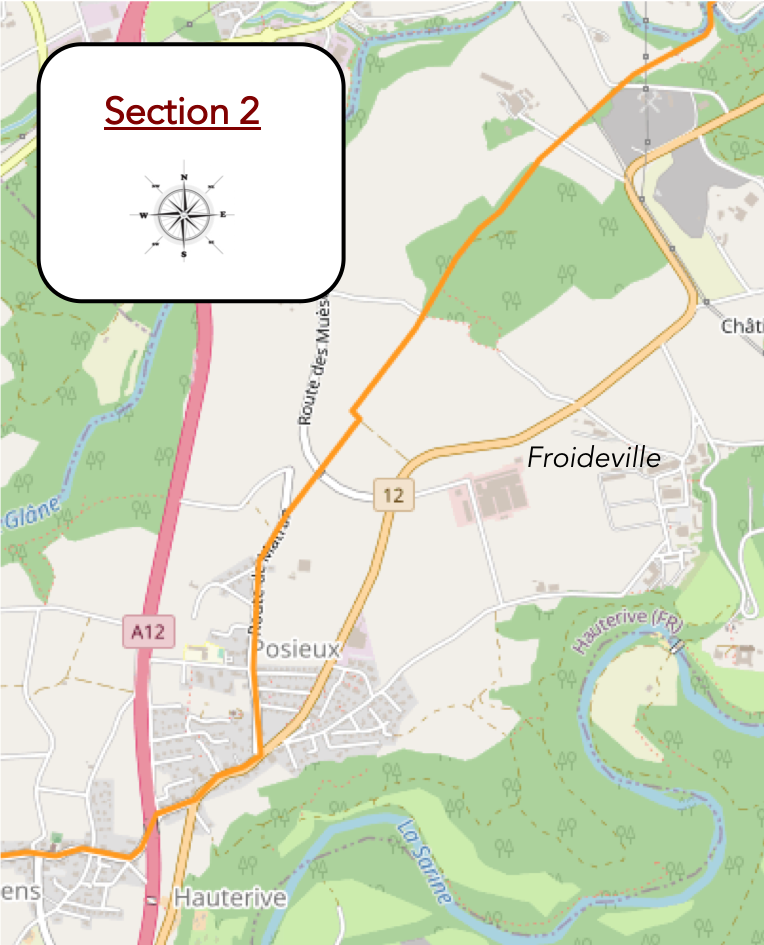
Overview of the route’s challenges: Some slopes near Froideville present a bit more of a challenge.

| From the graceful arch of the bridge, a trail escapes, snaking its way across the river through meadows, before crossing the Route du Moulin Neuf. |
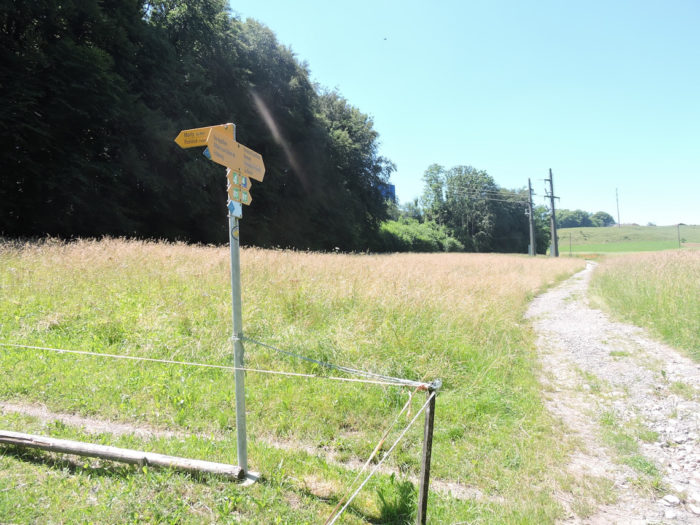 |
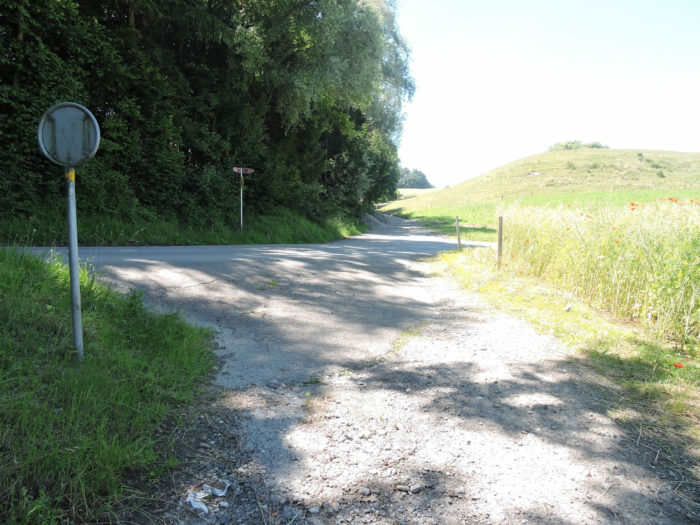 |
| On the opposite side, Villars-sur-Glâne unfolds like an urban tapestry, one of Fribourg’s suburban offshoots, where the Via Jacobi 4 usually meanders through. |
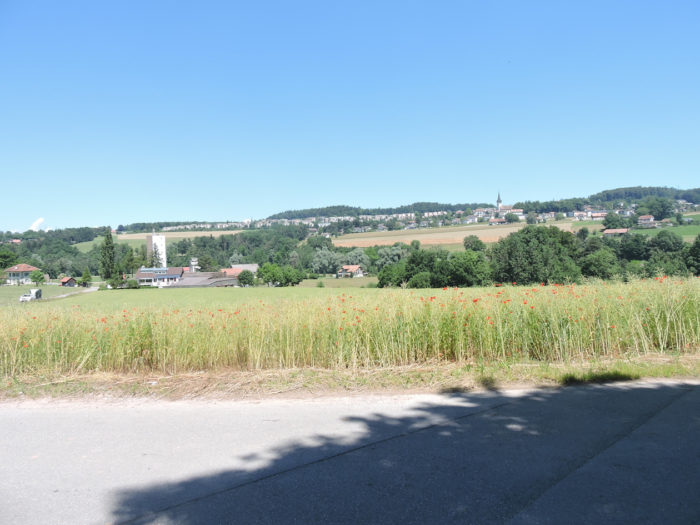 |
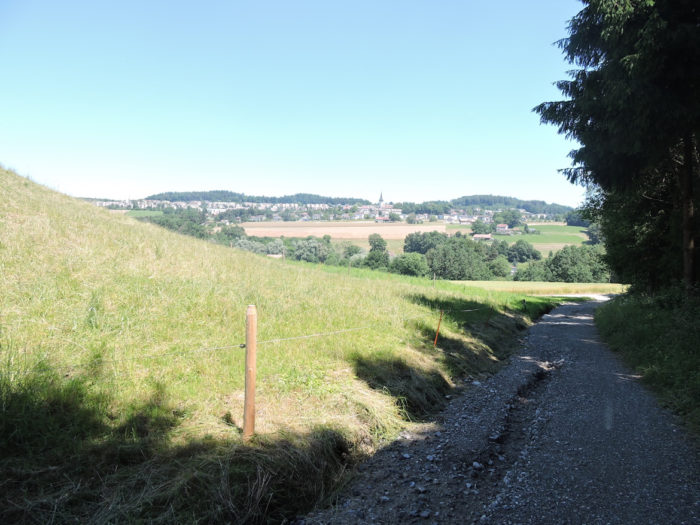 |
| The path, rugged underfoot, climbs steeply up the wooded flank, near a dormant quarry. |
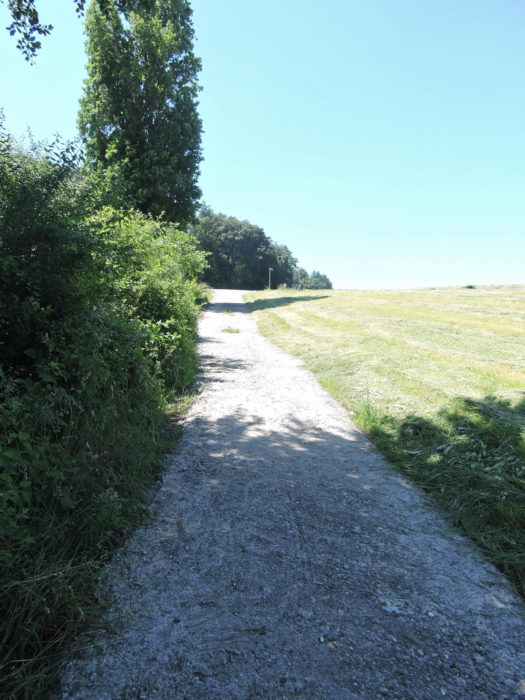 |
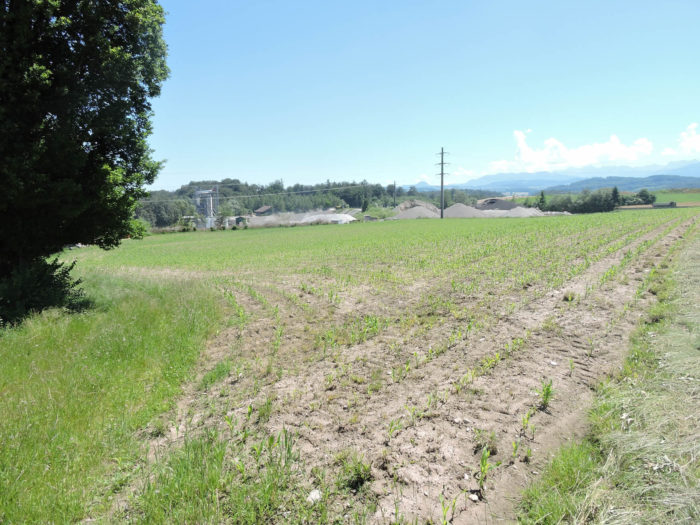 |
| It then emerges onto a narrow road, carved towards the hamlet of Froideville, acting like a swift vein through the landscape. Atop the hill, tranquility prevails, where only fleeting whispers disturb the silence, as if a green scarf were draped over the shoulders of the earth. |
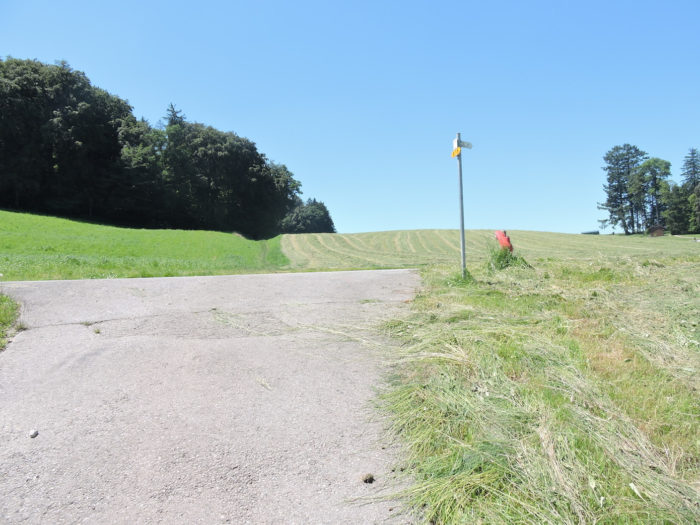 |
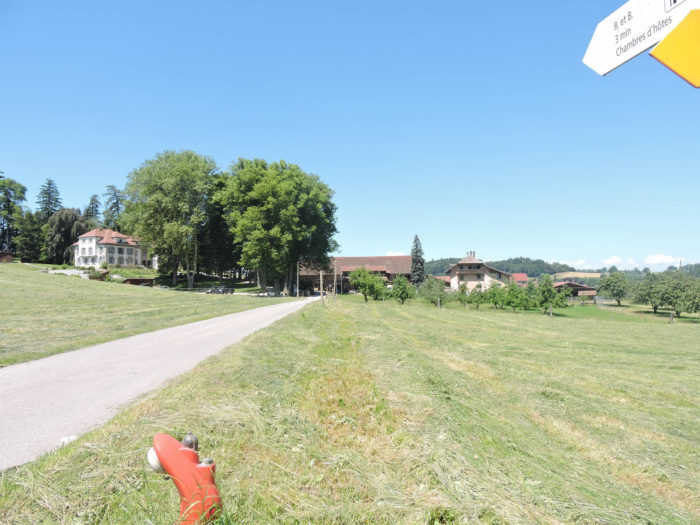 |
| Higher, the path climbs through lush meadows towards the Monterban forest. |
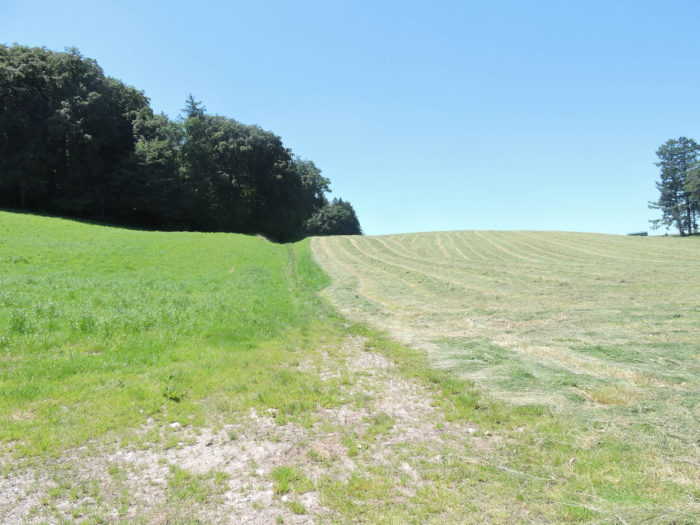 |
 |
| There, a forest track, almost sacred in its straightness, tackles the sustained incline of the woods. Here, in keeping with Swiss tradition, beeches reign supreme over the deciduous forests. |
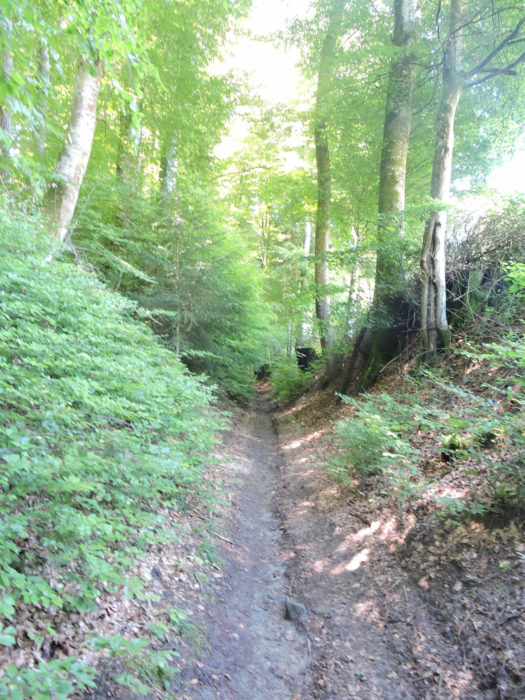 |
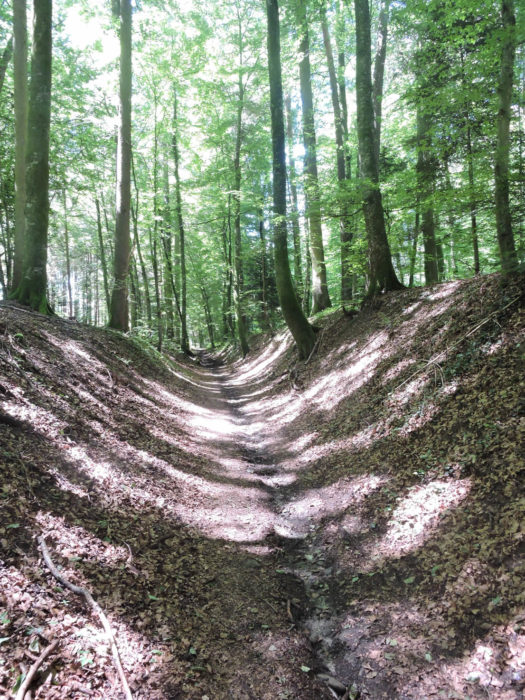 |
| At the forest’s edge, the incline softens on a broader path, where light bursts forth, dazzling. |
 |
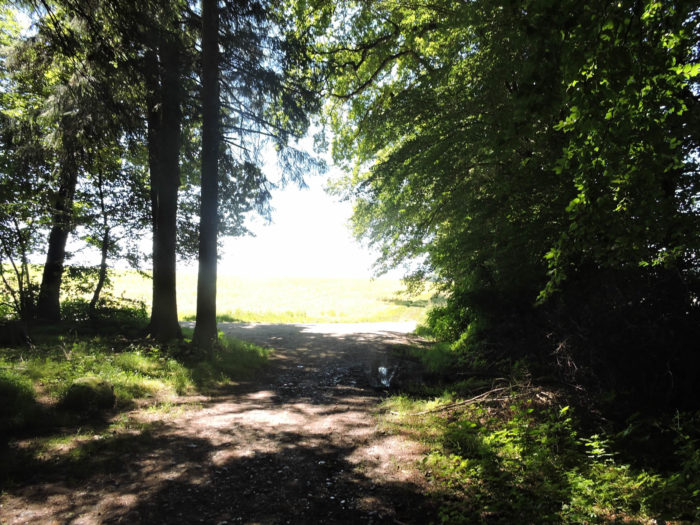 |
| Beyond a majestic oak, the hamlets of Posieux and Hauterive sprawl out, blanketing the plain in a village symphony. Yet, it’s more than five hours’ walk to Romont. |
 |
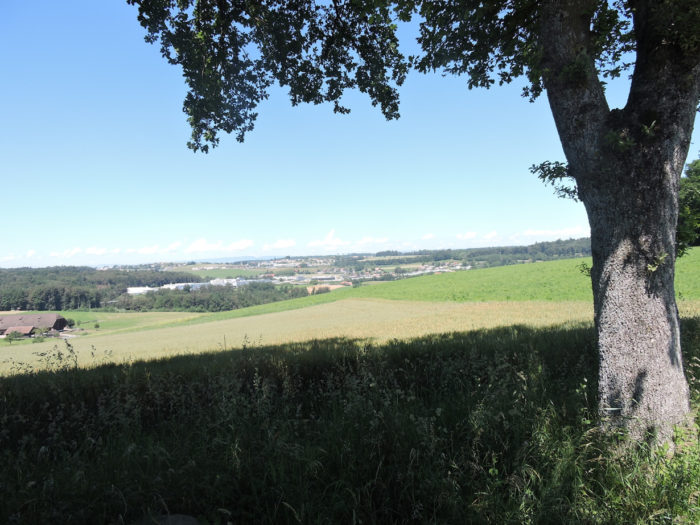 |
| The Via Jacobi then fades into the fabric of solitary meadows and woods. |
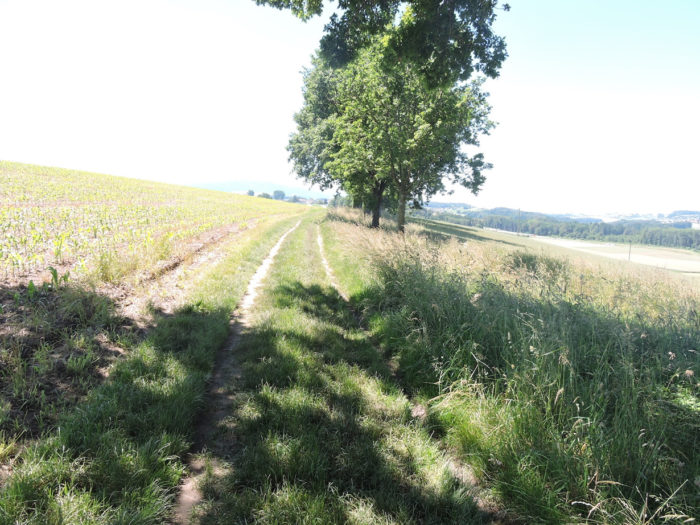 |
 |
| Further on, it joins a modest dirt road, winding its way through fields and crops. In this natural sanctuary, devoid of human intrusion, a profound tranquility reigns, as if the outside world were merely a distant echo. Shortly after, the path reaches a bridge. |
 |
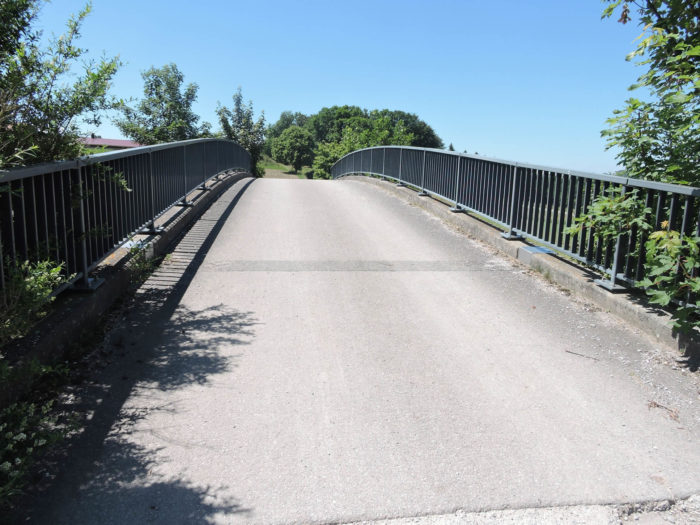 |
| Thereafter, a narrow road leads to Matran, another suburb of Fribourg, watched over by the imposing shadow of the distant highway. |
 |
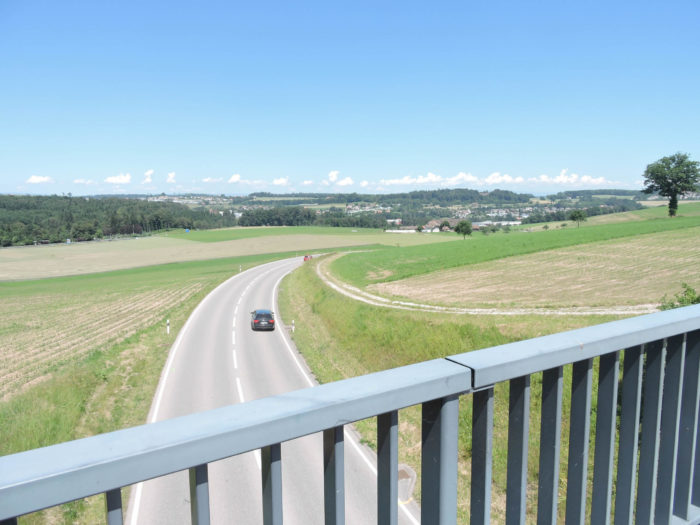 |
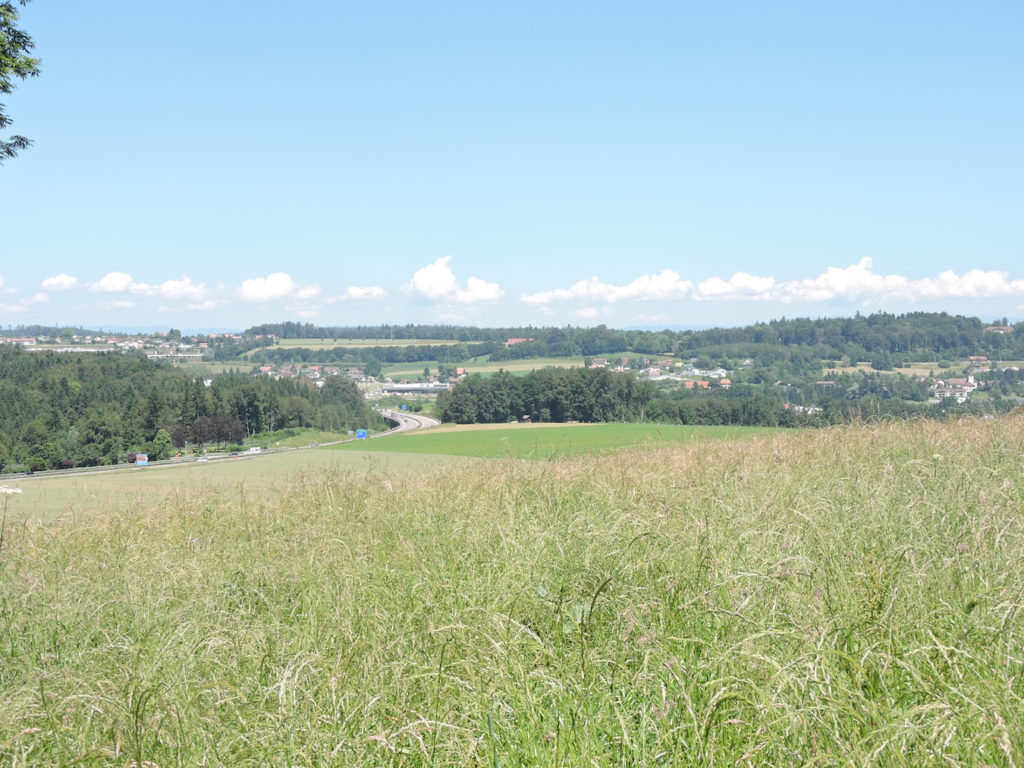
| The dirt path soon merges with a paved road, rising like a carpet of honor. |
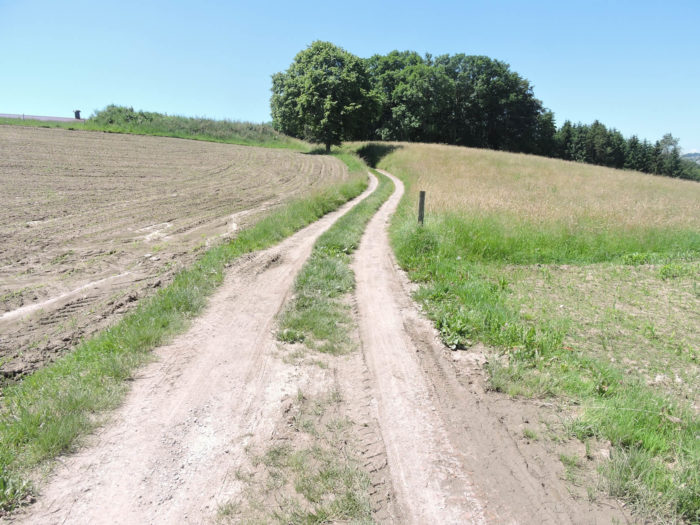 |
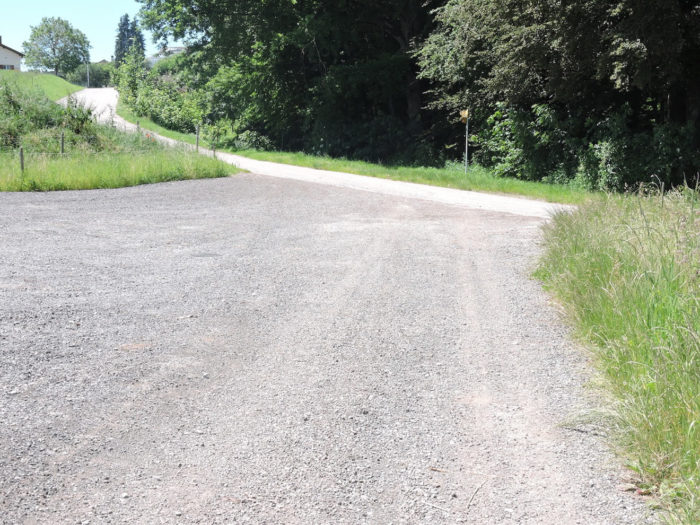 |
| Over time, the road approaches the first houses of the village of Posieux. |
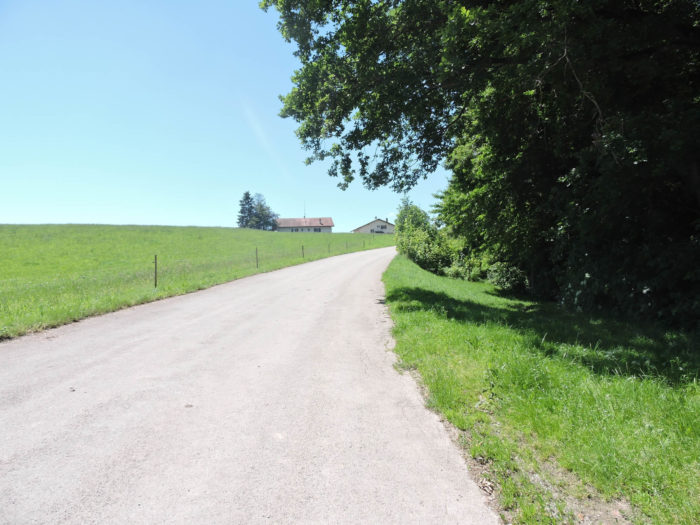 |
 |
| It then leads into a recent quarter of Posieux, with contemporary buildings, a sharp contrast to the traditions of the Germanic lands once traversed. These real estate developments, erected on the outskirts of villages, where new buildings once integrated seamlessly. It’s also worth noting that these towns, historically devoted entirely to agriculture, now frequently accommodate commuters working in the large city of Fribourg. |
 |
 |
| The road traverses Posieux, gently brushing past the modesty of a chapel—a sign you are faithfully advancing on the Way of St. James. |
 |
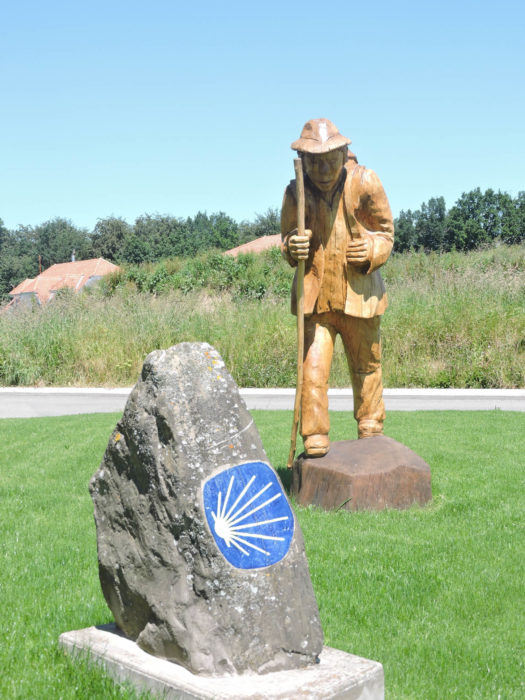 |
| Further, the road skirts two architectural jewels, also attesting to the cultural wealth of the Canton of Fribourg. |
 |
 |
| Then, you reach Posieux and the RN12, a highway connecting Fribourg to Bulle, its asphalt ribbon leading towards the freeway. |
 |
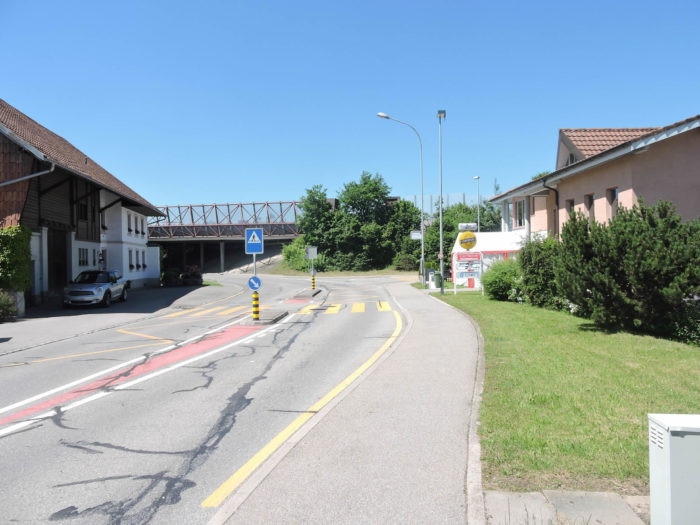 |
| The Via Jacobi subsequently dives under the concrete arch of the freeway, which boldly cuts through the village with its ceaseless roar. The route heads towards Ecuvillens, metaphorically, to the other side of the world. |
 |
 |
Section 3: A small airport and forests.

Overview of the route’s challenges: a route devoid of challenges.
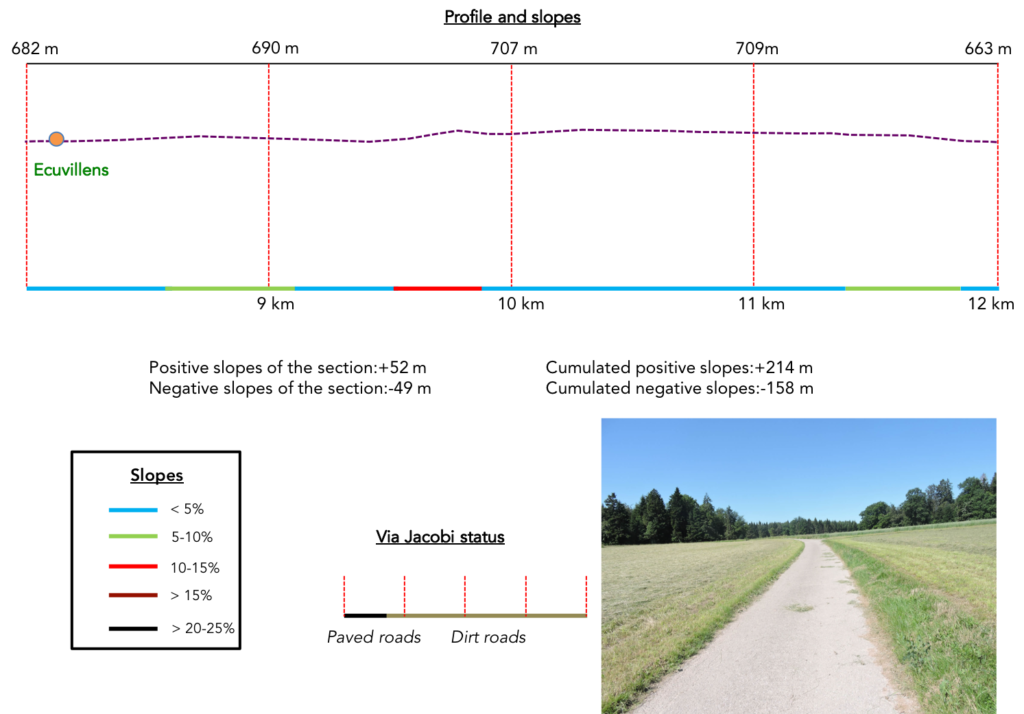
| In recent years, the region has witnessed numerous administrative adjustments. A continuous dance of decisions and reorganizations has sculpted the landscape, erasing familiar names to breathe in new life. Since the dawn of the new millennium in 2001, the small towns of Ecuvillens and Posieux have embraced each other, giving birth to Hauterive—a fusion of souls and lands. |
 |
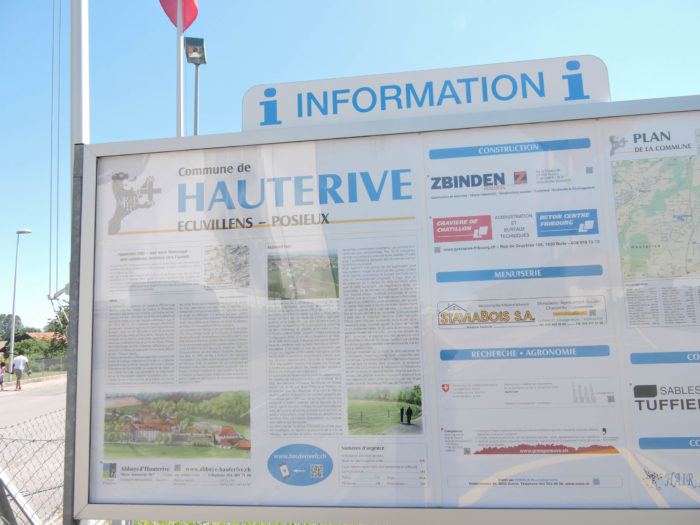 |
| However, behind the veil of administrative dealings, lies a timeless grandeur, a majesty frozen in the splendor of ancestral farms that dot the territory. Each of these buildings, a guardian of the past, whispers tales of yore, where life throbbed to the rhythm of seasons and harvests. Proudly adorned with poyas, these naive frescoes, remnants of folk art, trace the herds’ ascent to the alpine pastures, bearing witness to the deep identity of the Canton of Fribourg. Often executed on wooden panels or farm facades, these paintings are characterized by their naive and colorful style, highlighting bucolic landscapes, cow herds, alpine chalets, and human figures in traditional attire. Poyas are not only artistic works but also precious testimonials of Swiss rural history and culture, reflecting the profound relationship between humans and nature, as well as the ancestral traditions related to agriculture and livestock farming in the mountains. As masterpieces of a living art gallery, they stand alongside the naive paintings of the cantons of Appenzell and St. Gall, in a vibrant homage to tradition and rurality. |
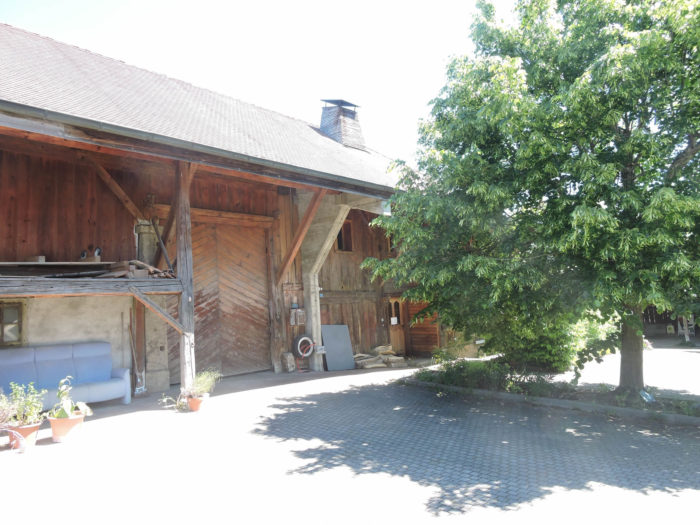 |
 |
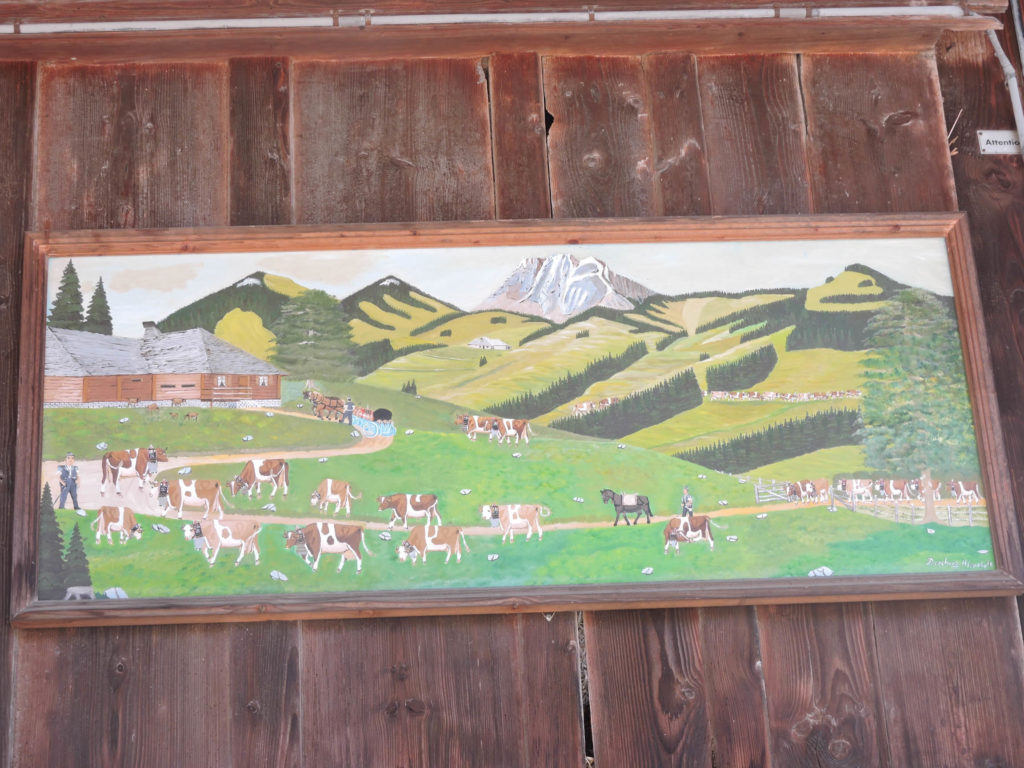
| The road winds like a silent sentinel past the school and church, two pillars of community life. In this preserved corner of the village, ancestral customs seem to still reign supreme, orchestrating daily life to the immutable rhythm of the seasons. |
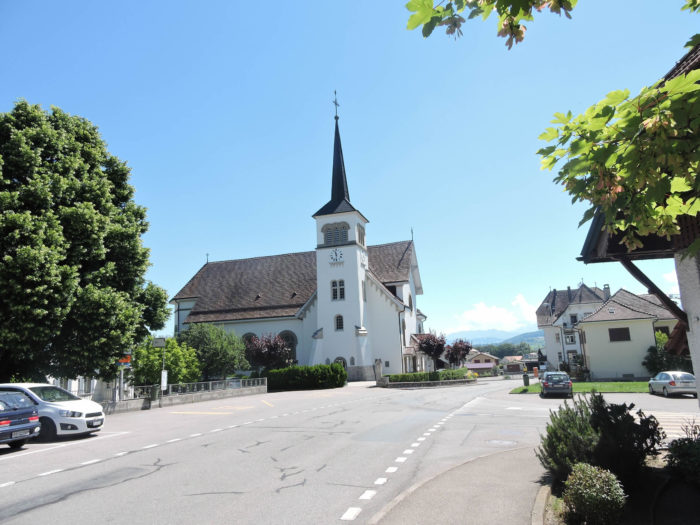 |
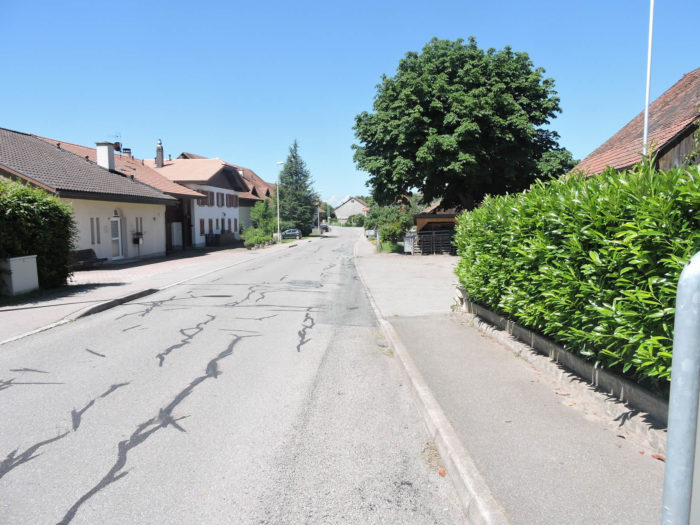 |
| Gradually, the village fades in the rearview mirror, giving way to the infinite horizon of fields and meadows stretching as far as the eye can see. |
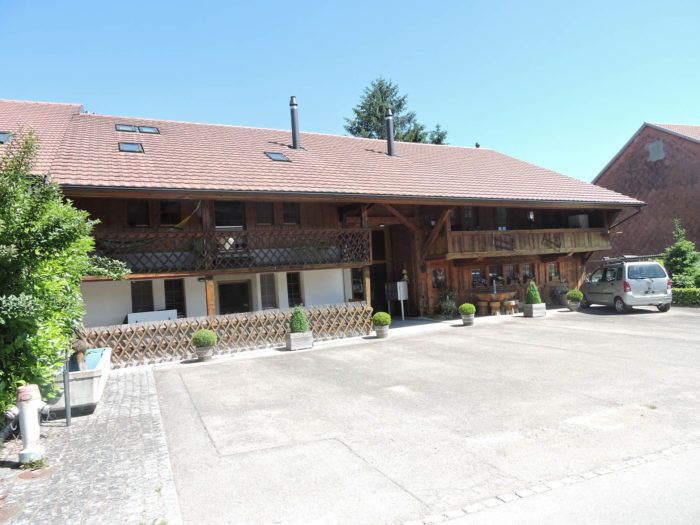 |
 |
| Upon leaving this haven of tranquility, a dirt road unfolds, extending an invitation towards the unknown, towards the Ecuvillens airport. |
 |
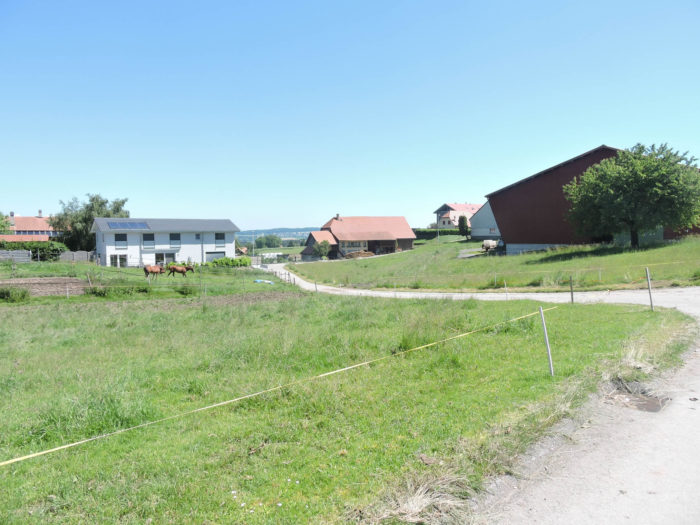 |
| The small country aerodromes breathe a particular charm, far from the frenetic hustle of large airport platforms. They are havens of peace, where each takeoff and landing is a moment filled with simplicity and authenticity. Away from the long queues and bustle of international terminals, these preserved places offer a more intimate and personalized flying experience. Pilots and regulars greet each other with knowing gestures, weaving close social bonds. These small aerodromes are not just departure points for local aerial escapades; they also serve as hubs of life and conviviality for local communities. Their modest buildings often house aeronautical clubs, flight schools, and maintenance workshops, where enthusiasts gather to exchange, share, and celebrate their common love for aviation. |
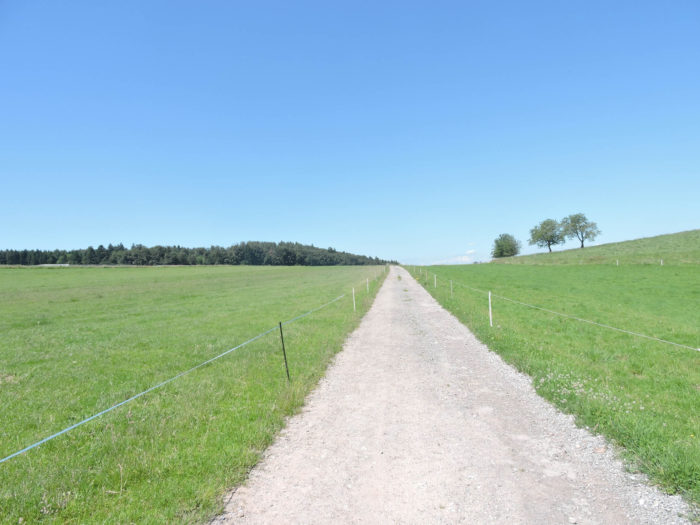 |
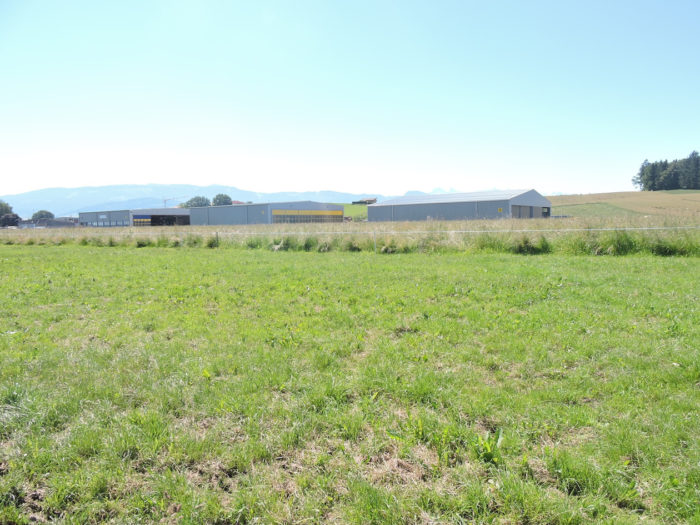 |
| The path snakes through verdant meadows and golden cornfields until it reaches the runway’s end, where metal wings defy gravity in a sustained ballet. |
 |
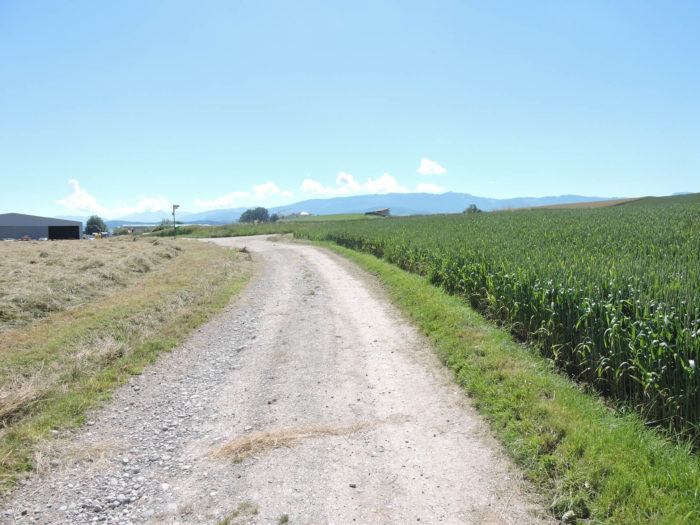 |
| Behind the airport, a dirt path named St. Jacques Road plunges into the dense canopy, promising an escape into the heart of wild nature. |
 |
 |
| Further on, the path nestles among majestic trees, where beeches, oaks, and maples stand as the immemorial guardians of this ancient forest. The forest, in all its splendor, sings an ode to beauty and serenity, inviting the wandering soul to lose itself in its twists and turns. |
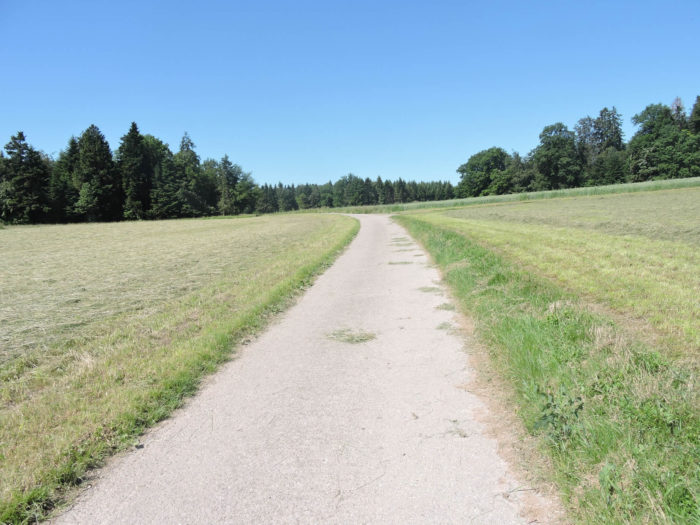 |
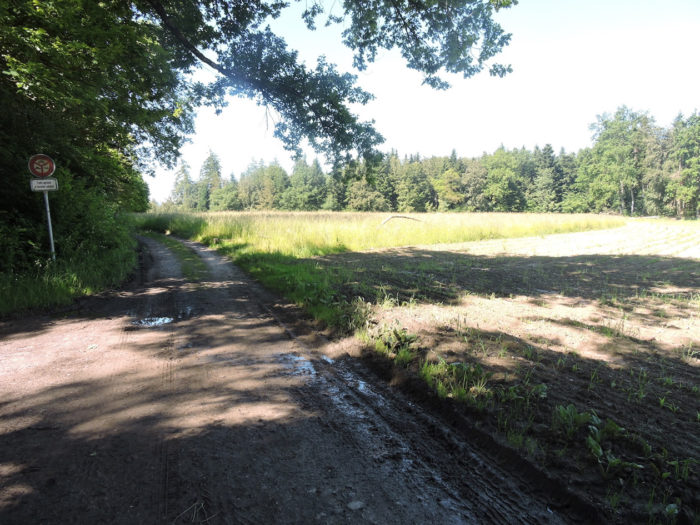 |
| At the edge of the woods, the landscape opens like a book with infinite pages, revealing a panorama of rolling hills where fields and meadows merge, forming living paintings. |
 |
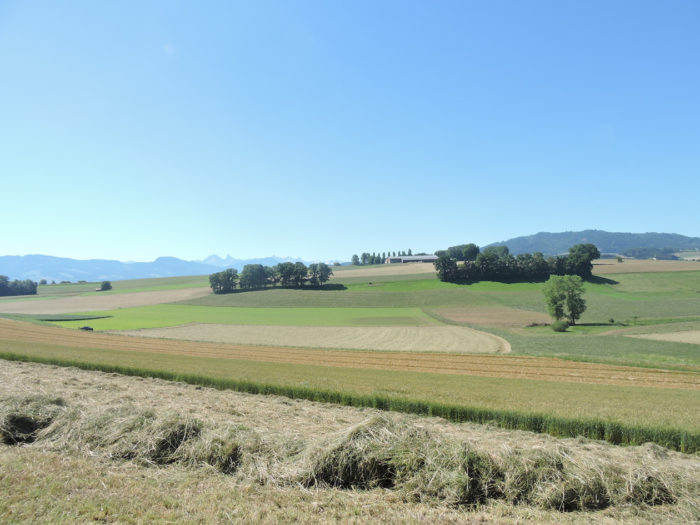 |
| A road then plunges into the countryside, like a frenzied dance, towards Posat, where familiar outlines blend into the approaching horizon. |
 |
 |
Section 4: A beautiful river and cows in the meadows.

Overview of the route’s challenges: The trail presents no significant challenges, aside from crossing the river.
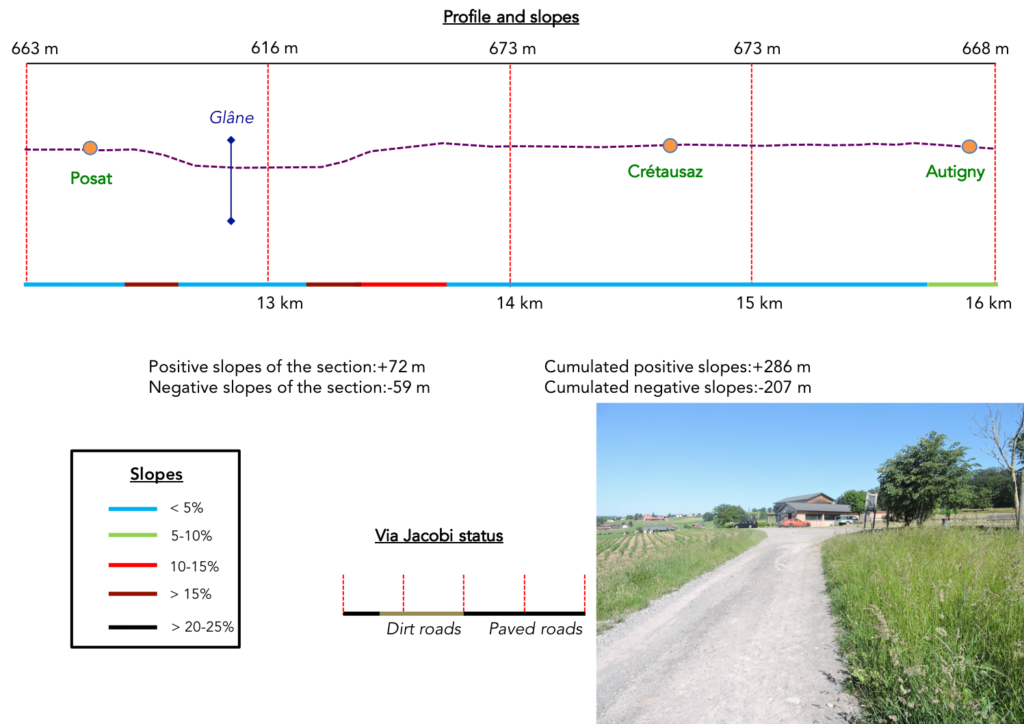
| In the vastness of nature lies Posat, a hamlet where life pulsates to the rhythm of the earth, like a beating heart within the canton of Fribourg. Hidden within verdant folds, this tranquil village unveils the very essence of rurality. |
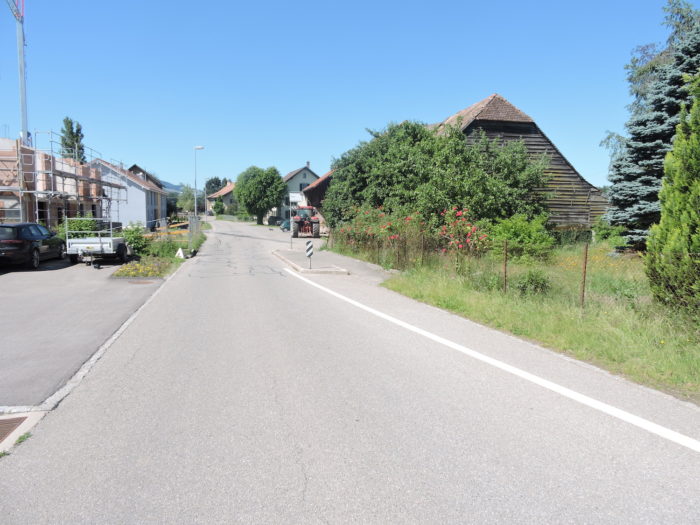 |
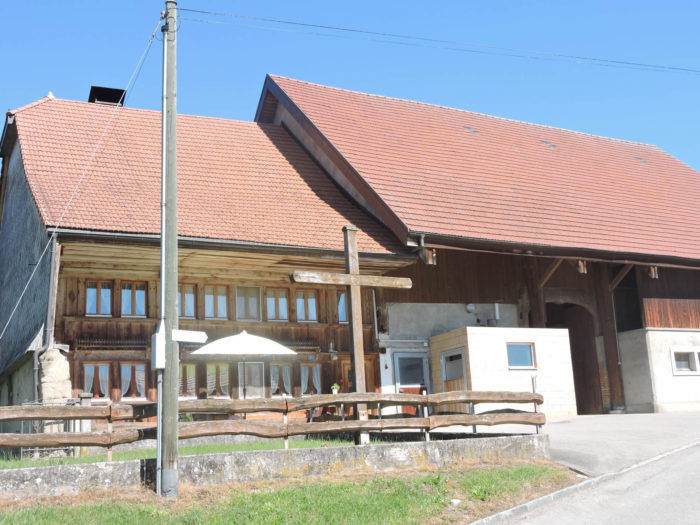 |
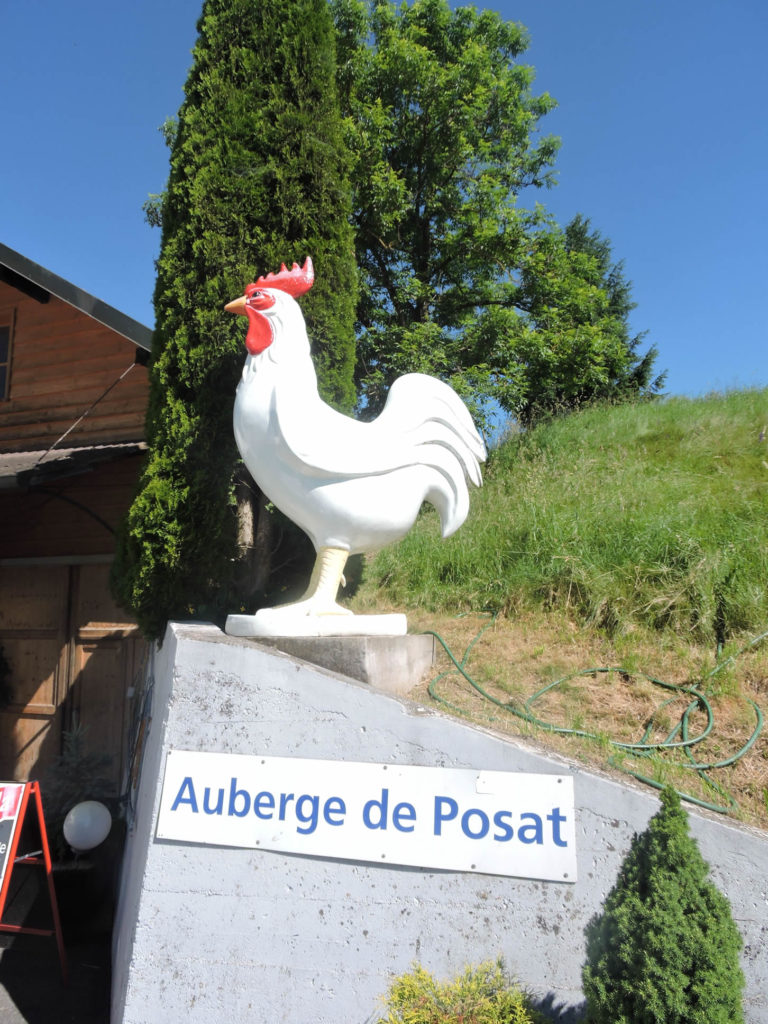
| Here, as is the case throughout this land of meadows and milk, the hallowed cheese dairy remains a living temple, where local milk is transformed into golden treasures such as Gruyère and Vacherin Fribourgeois, sacred components of the famed Swiss Romande fondue. Within the peaceful hamlets dotting the canton, it’s almost guaranteed that your steps will invariably lead you to a cheese dairy, while bakeries become rare, if not elusive. |
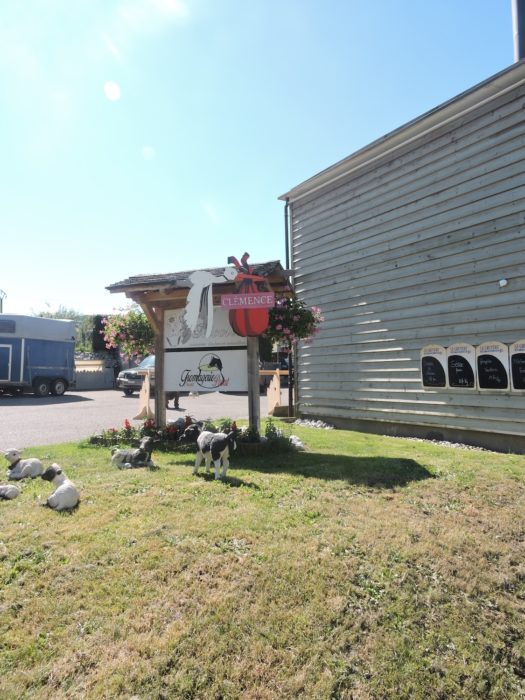 |
 |
| Under the benevolent gaze of the village stands the Notre-Dame chapel, a secular witness to pious devotions. A venerable edifice, with roots extending into the mists of the Middle Ages, its slender silhouette seems to embrace the sky, while its history-laden walls whisper the prayers of pilgrims of yore. |
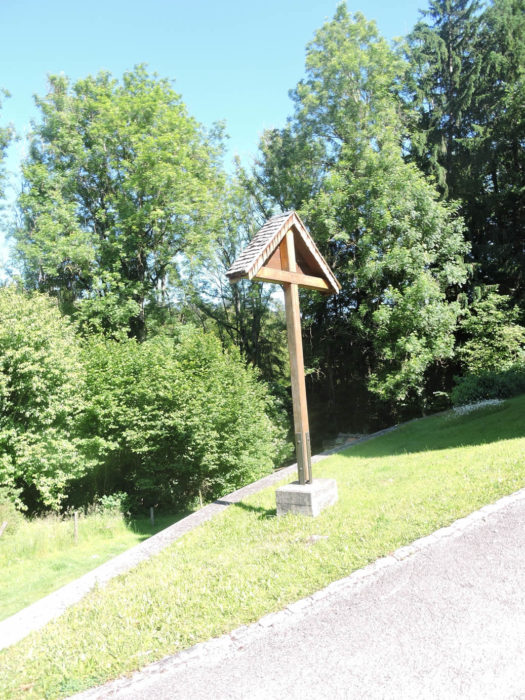 |
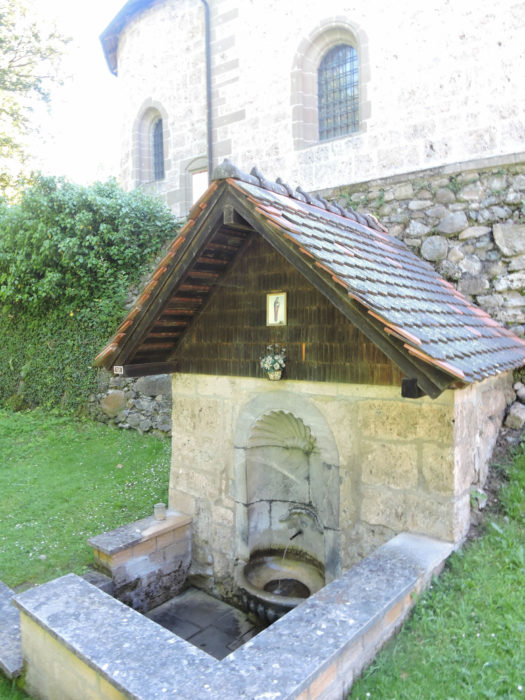 |
| A path, like an escape to elsewhere, begins just below the chapel, daringly delving into the valley that stretches out like a ribbon of emerald. There, between the steep folds, a rocky path emerges, challenging verticality with fierce elegance. Timid barriers, modest stairs punctuate this descent, discreet witnesses to a journey into the heart of natural majesty. |
 |
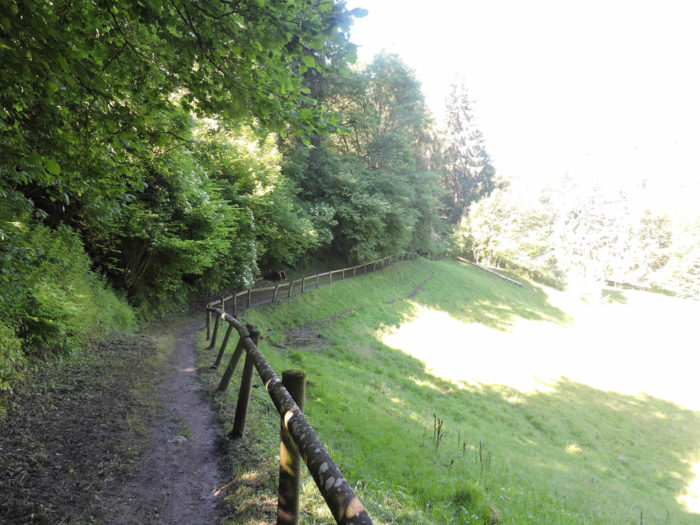 |
| Nestled in the valley’s embrace, the Glâne, a peaceful river with crystal-clear waters, serves as a tranquil mirror reflecting dreams. |
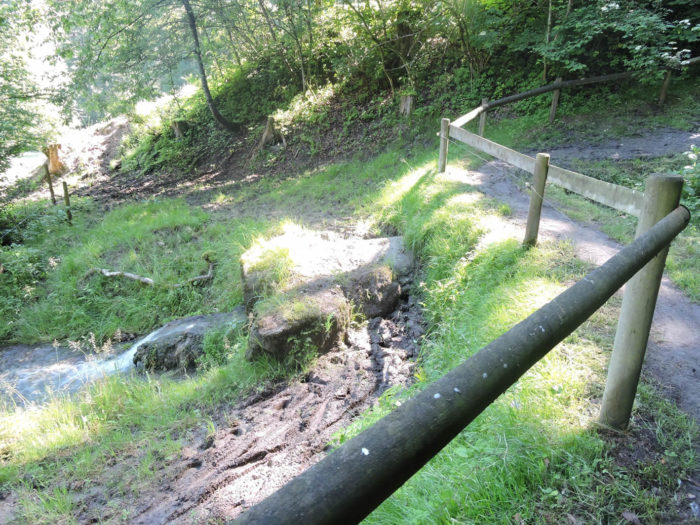 |
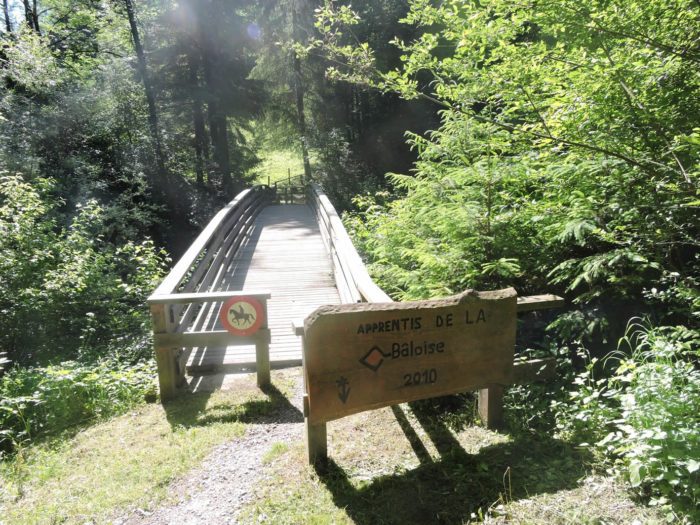 |
| Here, in this sanctuary of coolness and tranquility, time stands still, inviting the lost traveler to a beneficial pause. |
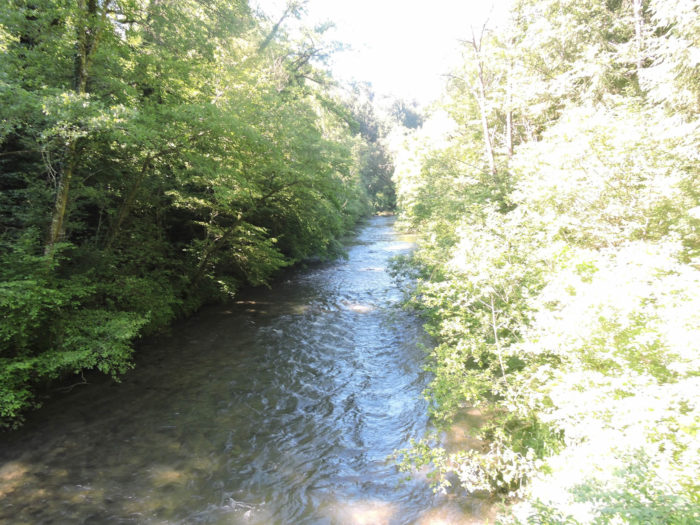 |
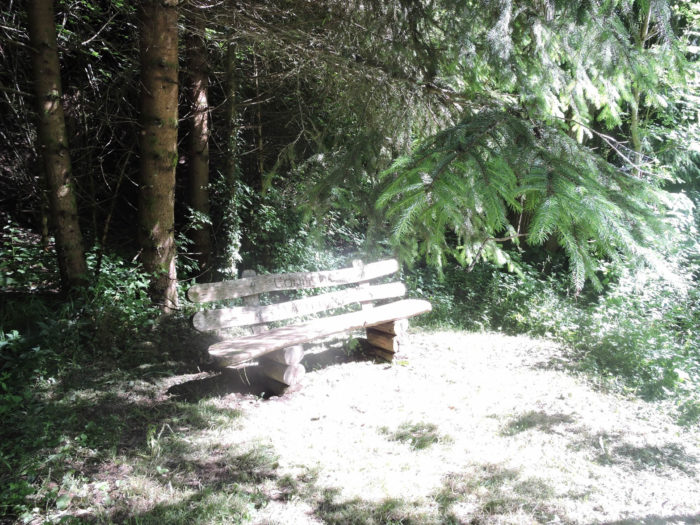 |
Imbued with this serenity, one’s gaze then falls upon a maxim engraved on a stake, like a prophetic sentence whispered by the ancestors. Enigmatic yet enlightening, it echoes in the soul of the wanderer, offering a moment of meditation, a breath of reflection.
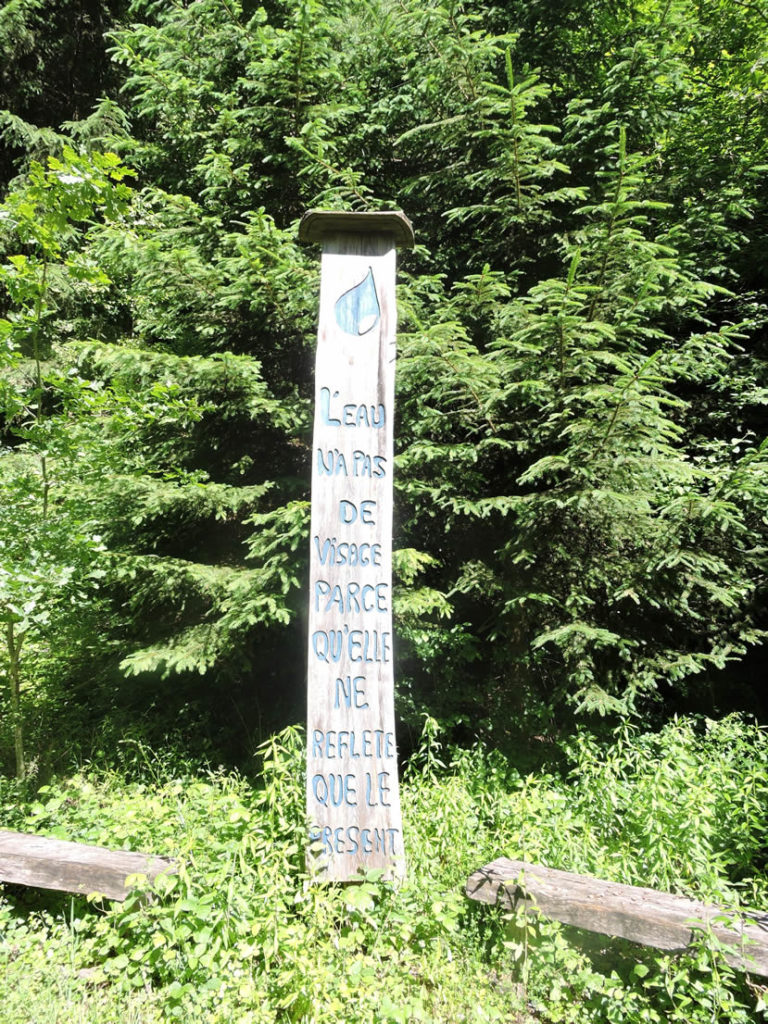
| Like a stone serpent, the rocky path steeps up on the opposite side of the valley, unfurling its mineral tongue with fierce elegance. Less steep, less severe, it embodies the ascent towards the light, towards a horizon that opens up as one climbs the earth’s rungs. |
 |
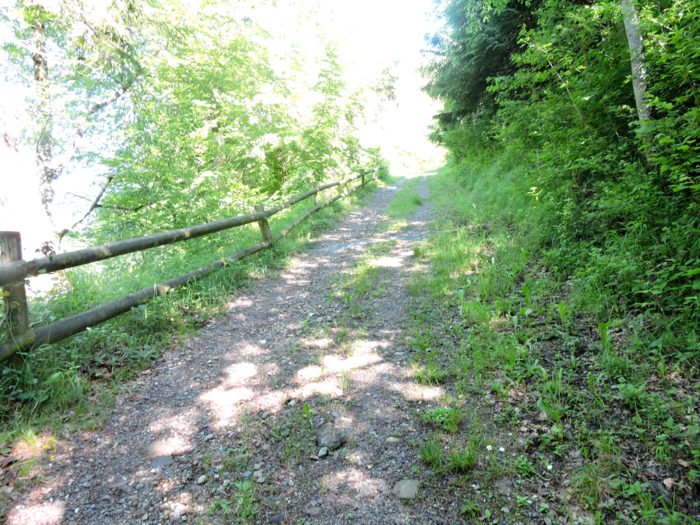 |
| And suddenly, the canopy disperses, giving way to a pastoral scene of undulating meadows and a few cornfields. |
 |
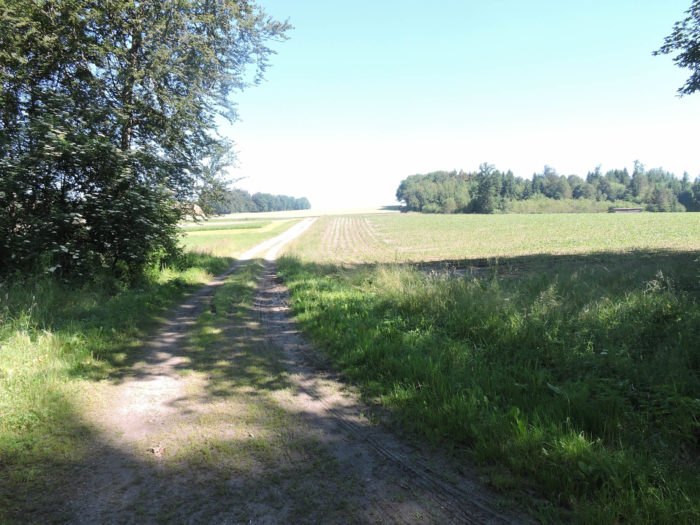 |
| There, the Gibloux hill stands, its majestic silhouette cutting across the horizon like a beacon in the night. |
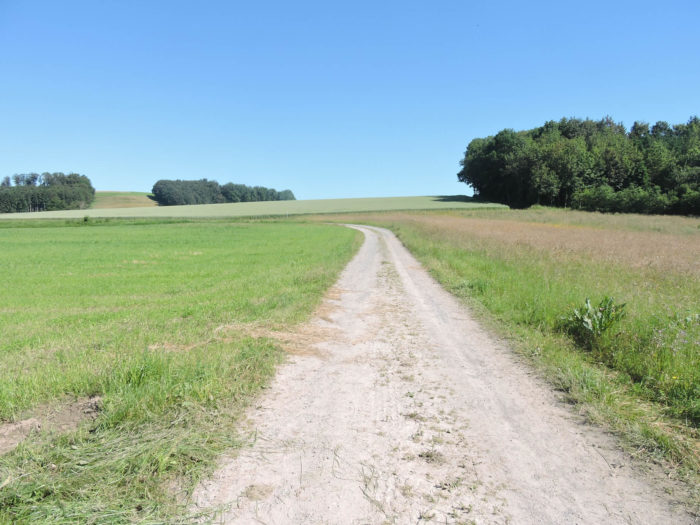 |
 |
| The path then meanders through fertile lands, between pastures and crops, like a silver thread embroidering the green fabric of the countryside. And soon, in a sigh of dust, it emerges onto the hamlet of la Crétausaz, a tranquil enclave where time seems to stand still, as is often the custom among farmers. |
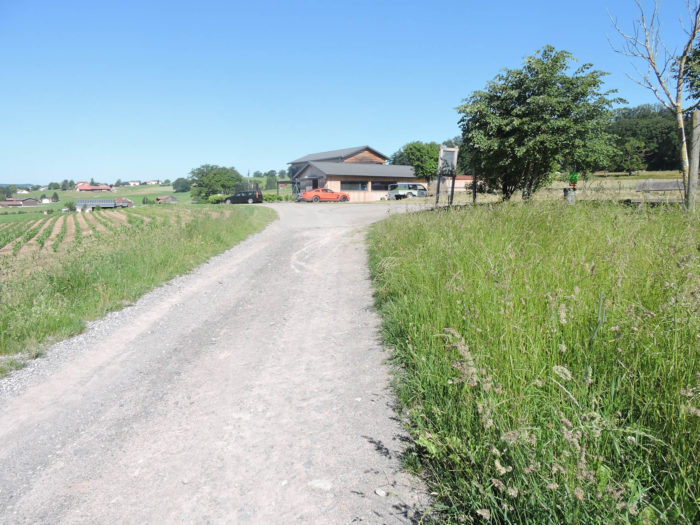 |
 |
Here, a cross, standing proudly, guides the steps of lost travelers, reminding of the unshakeable faith dwelling in the hearts of this spiritually imbued canton.
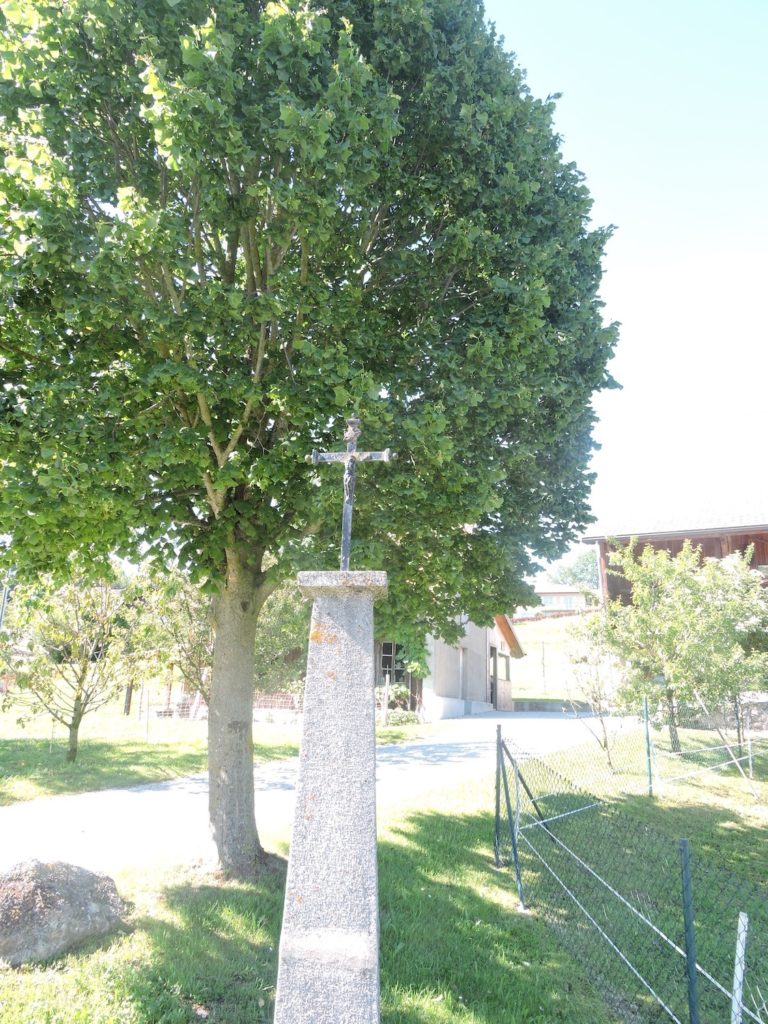
| And as the small road delves into the heart of the hamlet, it reveals, at the bend of the paths, solitary farms and meadows where cows graze, a pastoral image of a simple and authentic life. |
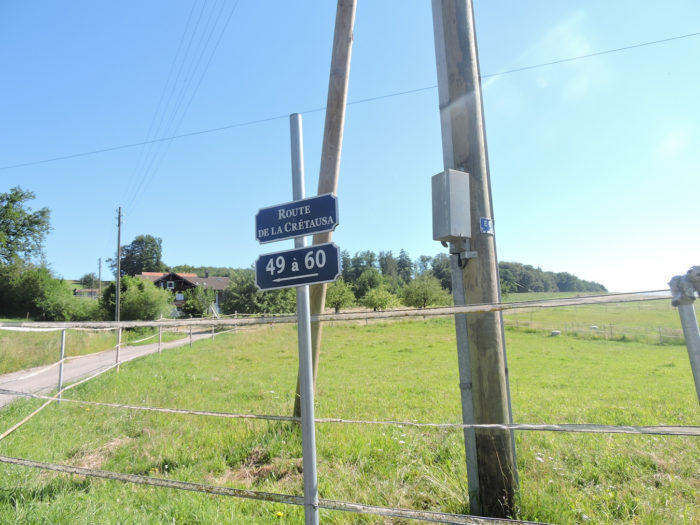 |
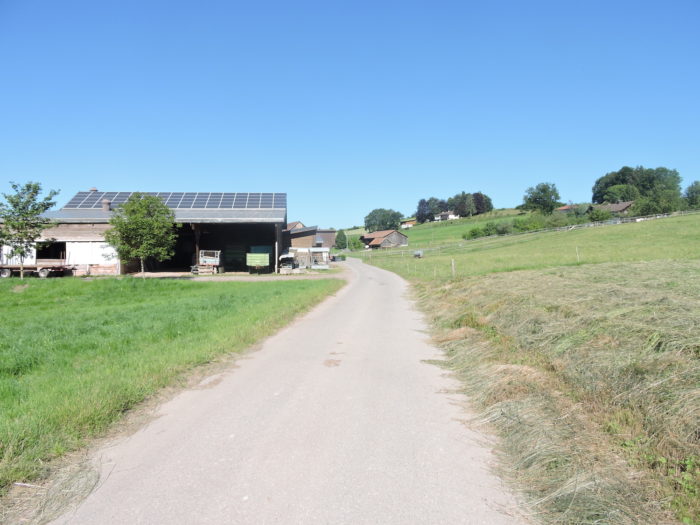 |
 |
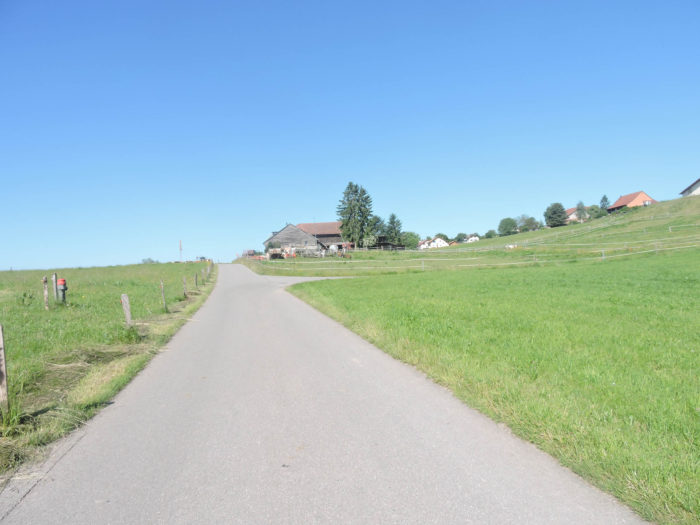 |
| A legend persists, conveyed by whispers from the cities: it is murmured that the number of cows exceeds that of human souls wandering these lands. However, facts contradict this belief, although the territory is undoubtedly the realm of Gruyère, this land where the cheesemaking tradition reveals its art. Here, among the green pastures stretching as far as the eye can see, the striking Holstein, black and white, reigns supreme, a perfect symbol of the canton’s chromatic harmony.
Once, a robust breed roamed these lands, the “Fribourgeoise,” proudly adorned with its black and white spots, evoking an epic reminiscent of the tragedies of ancient Greece. Soon, the black and white cow, bearing the canton’s emblematic colors, became Fribourg’s bovine icon. We are propelled into the heart of the 20th century, an era where farmers devoted an unwavering love to their horned companions and prided themselves on their heritage. But as foreign breeders perfected their methods, exploring the subtleties of artificial insemination, locals rested on their laurels, neglecting advancements in breeding. Between 1920 and 1946, the once flourishing herd, numbering 40,000 heads, plummeted to 25,000, casting a threatening shadow over the future of this ancestral breed. Faced with this decline, what was to be done? Rural Switzerland of the time favored the Swiss Brown and the spotted Simmental. But times changed, not only in Switzerland but across the world. The necessity to produce more milk, regardless of the breed, became paramount. The “Fribourgeoise” offered a moderate milk yield, a problem reminiscent of our walks among the Aubrac herds. To improve the quality of the livestock, breeders undertook frenzied crossbreeding, mating the “Fribourgeoise” with Black Pied Frisians, thus creating the Prim’Holstein, a hybrid between the original Frisian and the Holstein. The results were mixed, so attempts were made to mate with black or brown Canadian Holsteins. In 1966, the massive importation of 1,000 doses of Holstein semen from Canada marked a decisive turning point. More productive in milk than the “Fribourgeoise” and free from the genetic defects that plagued it, the Holstein naturally imposed itself, especially as breeders aimed to preserve the animal’s characteristic black and white. The success was resounding, with butter piling up on the stalls, while the poor “Fribourgeoise” slowly faded away, until in 1975, the last authentically Fribourgeois bull, Héron, was led to the slaughterhouse. The farmers of Fribourg, in their silence, hide their bitterness over the disappearance of their emblematic breed. Now, they roam the globe in search of their lost queen, for the “Fribourgeoise” was successfully exported. Recently, black and white specimens, descendants of this lineage, have been spotted in Chile, but their purity is compromised by crossbreeding. History is in motion… A proof that not all cows are simply black and white. One will also encounter the Red Holstein, brown and spotted, although other bovine breeds are exceedingly rare in these lands. Each breed crossing has its own syndicate in the canton, revealing meticulous organization and a deep attachment to these ancestral traditions. |
 |
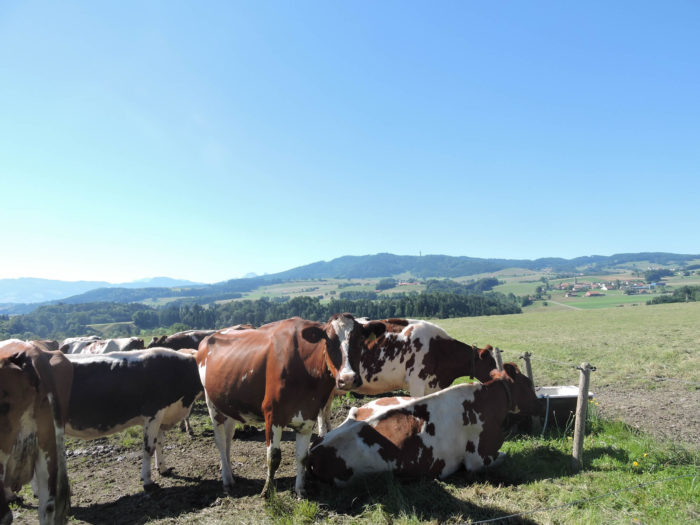 |
| From farm to farm, the path winds its way to the village of Autigny, a modest agricultural hamlet of 796 souls, where one can find refuge and comfort. |
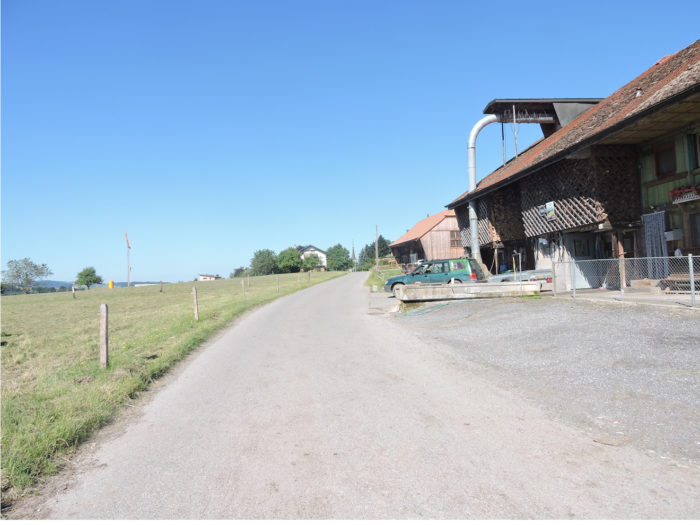 |
 |
| The neoclassical church of Saint-Maurice, built at the beginning of the 19th century, shines brightly, adorned with magnificent stained-glass windows that captivate the soul of the visitor. |
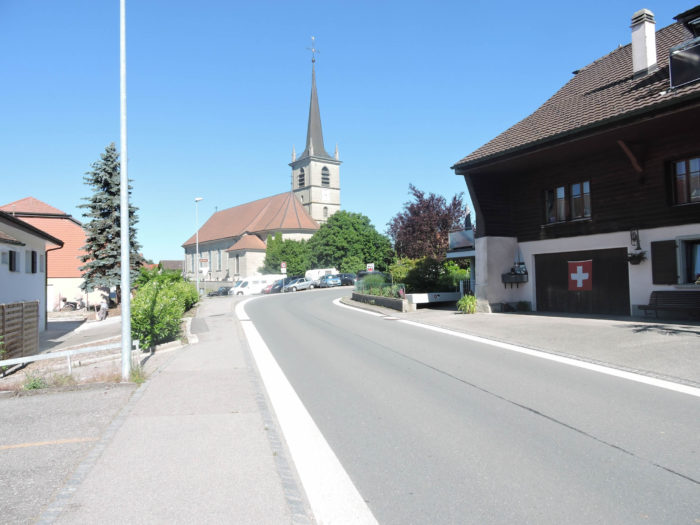 |
 |
| Among the ancient homes dotting the landscape, some exude a timeless charm, silent witnesses to the passage of centuries. Three hours’ walk still echoes the name of Romont, like a call to adventure, an invitation to continue this journey into the heart of Fribourg’s pastoral lands. |
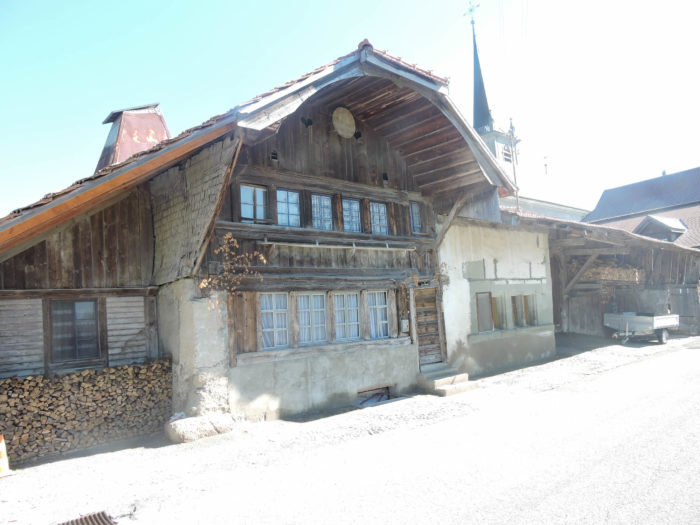 |
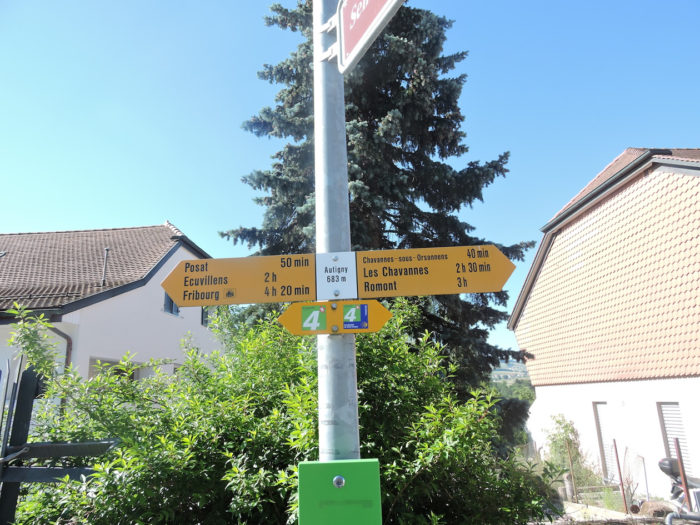 |
Section 5: In the Fribourg meadows.
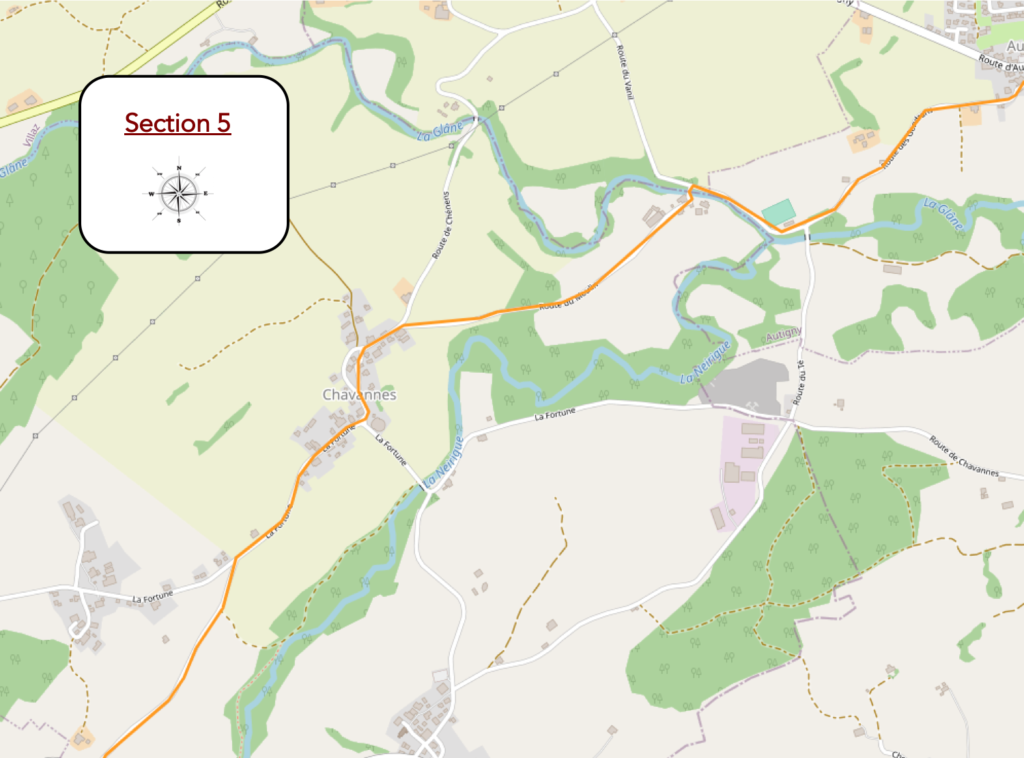
Overview of the route’s challenges: smooth sailing.

| The road gracefully undulates as it descends from Autigny, plunging into a fluid ballet through the meadows towards Neirigue brook. |
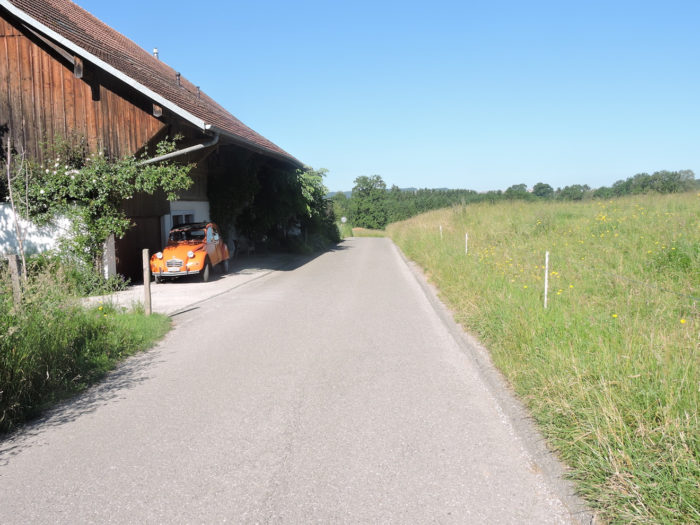 |
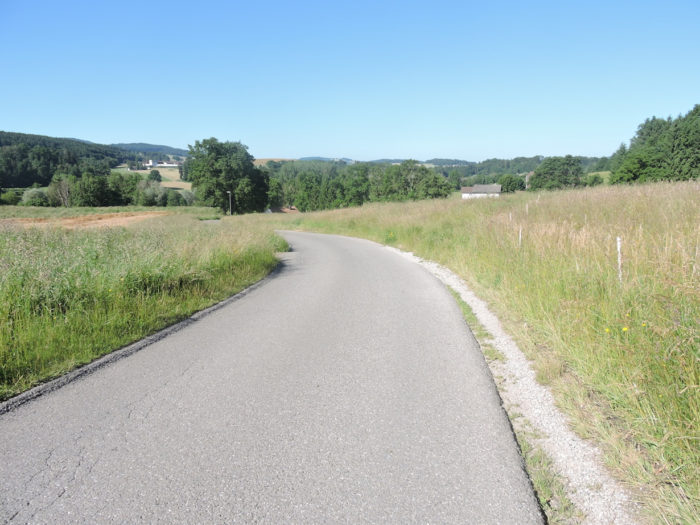 |
| In this vast expanse, it follows the curves of the stream, which winds like a silver ribbon through the plain. |
 |
 |
| Soon it crosses the threshold of the place called Le Moulin, majestically traversing the turbulent waters of the Glâne, where Neirigue also merges. |
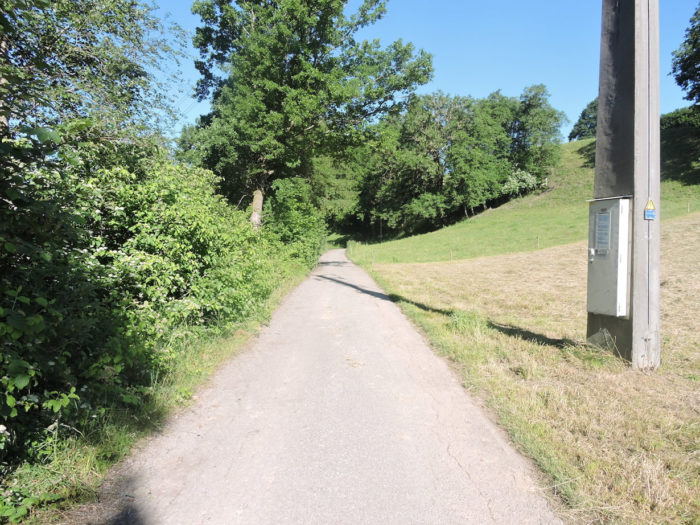 |
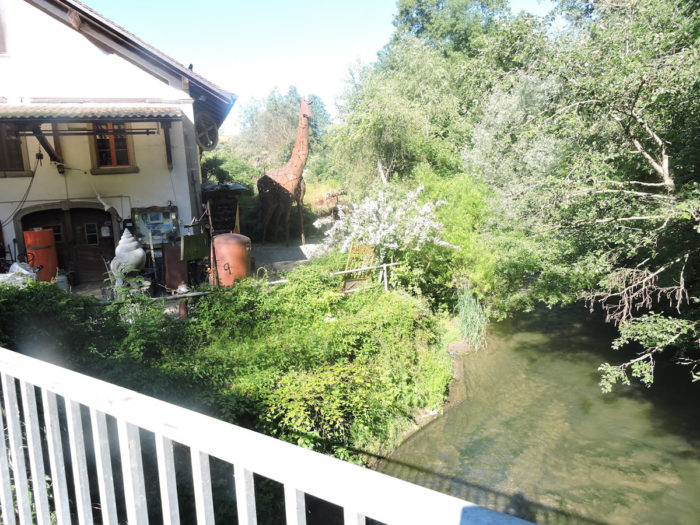 |
| Once, the clicking of a mill’s gears enlivened these waters, but now only the imprint of an antique dealer remains, erecting his realm by the water’s edge. |
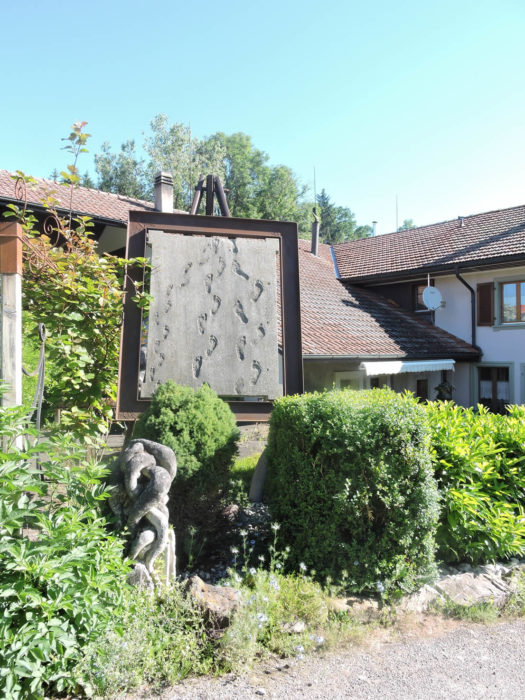 |
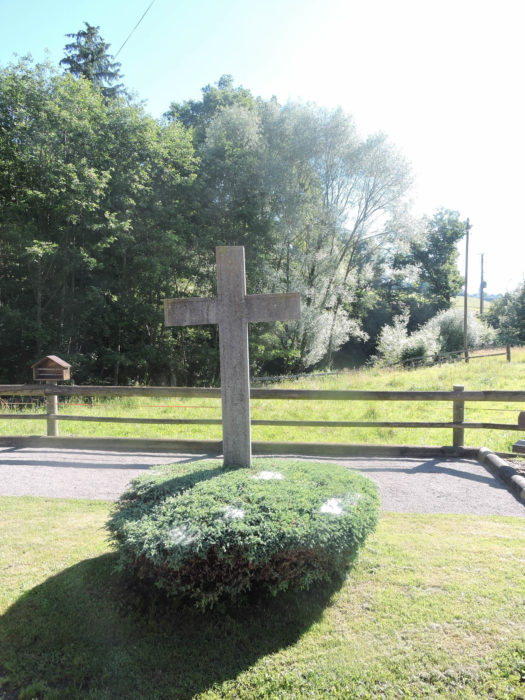 |
| From there, the road resolutely ventures towards a grove of trees, where hardwoods and spruces harmoniously intermingle. Here, the air is scented with the freshness of the forest, caressing travelers’ senses with its soothing murmur. |
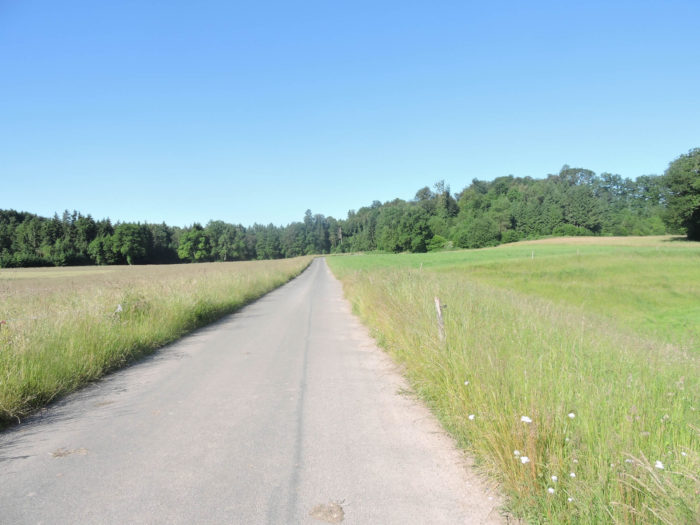 |
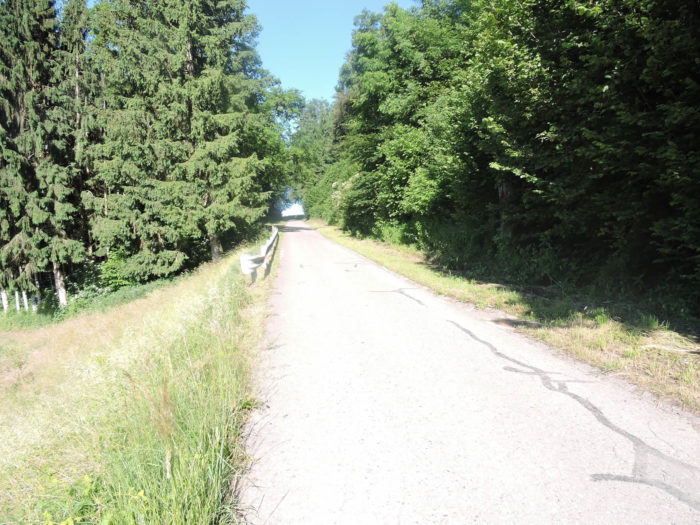 |
| Soon, the first houses of Chavanes-sous-Orsonnens emerge on the horizon, while on the left, the imposing silhouette of the Gibloux antenna looms like a sentinel watching over these peaceful lands. |
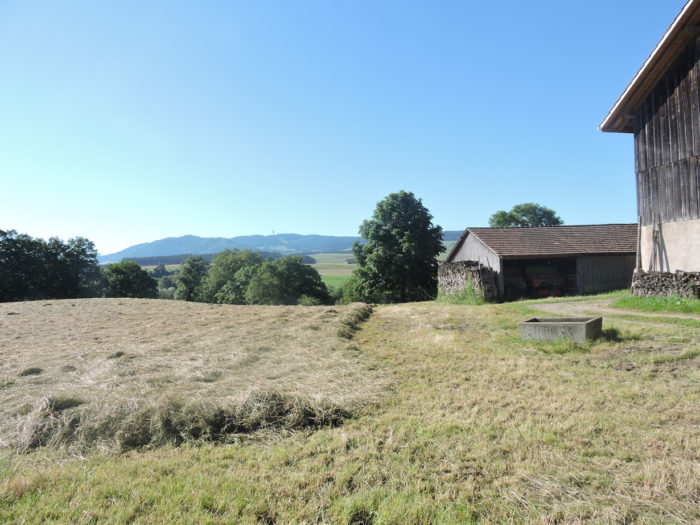 |
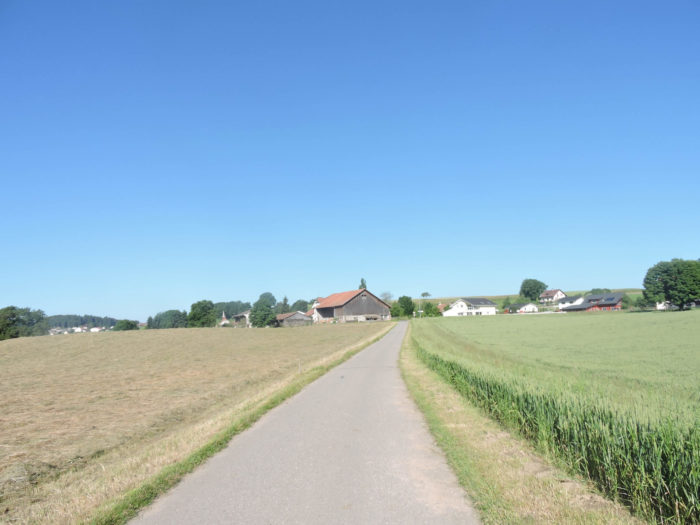 |
| Further along, the road reaches the summit of the village. Here, in this predominantly agricultural region, farms stand in a symphony of sizes and shapes, bearing witness to the diversity of a life centered on the nurturing earth. Fribourg, guardian of traditions, remains above all the vibrant symbol of a canton devoted to agriculture. The road comes to a halt near a stone fountain and a venerable chapel, erected in honor of Saint John the Baptist. |
 |
 |
| Dating back at least to the 16th century, this chapel, though restored over the ages, continues to leave its secular mark. |
 |
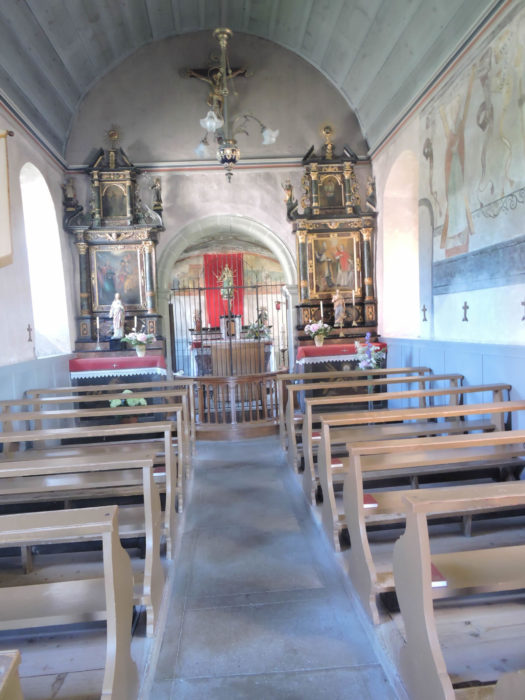 |
| Descending from the heights of the chapel, the road winds into the heart of the village, revealing a pastoral scene where agricultural activities punctuate the daily lives of the inhabitants. Farms proudly display their insignias, tokens of success achieved in agricultural competitions. Here, there is no ostentatious display for passing strangers. No, it is among themselves that this silent contest plays out, this perpetual quest for excellence. Every plowed field, every cared-for animal, every abundant harvest becomes a challenge thrown down to the neighbor next door. A rivalry tinged with mutual respect, where the true stakes are not so much external recognition as personal satisfaction and community respect. |
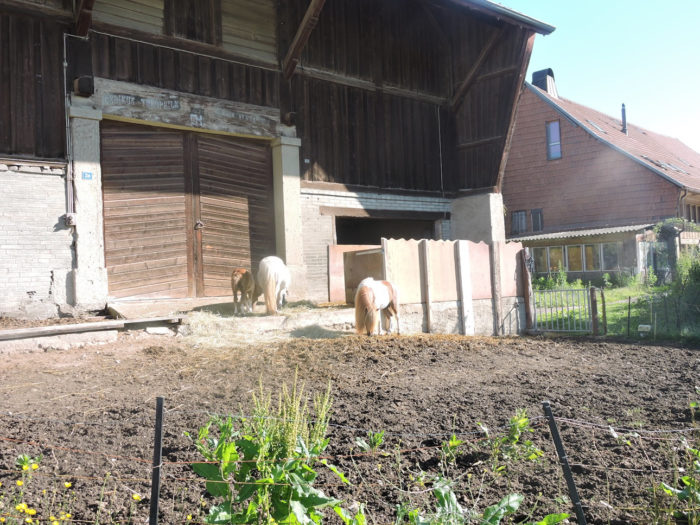 |
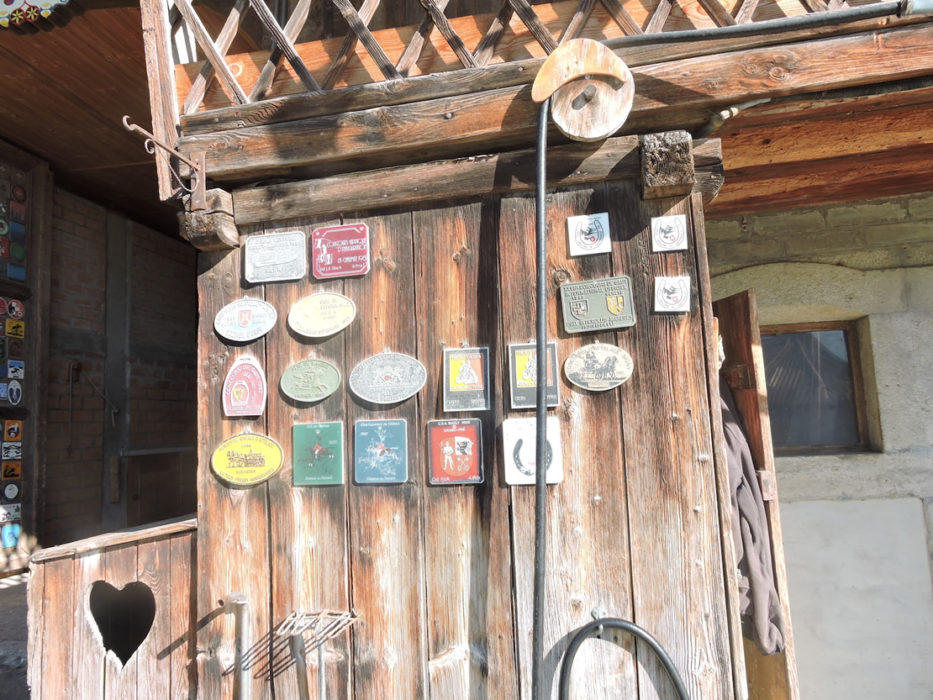 |

| Surging out of the village, it merges onto the road named La Fortune, where travelers’ destinies intertwine with the designs of the horizon. |
 |
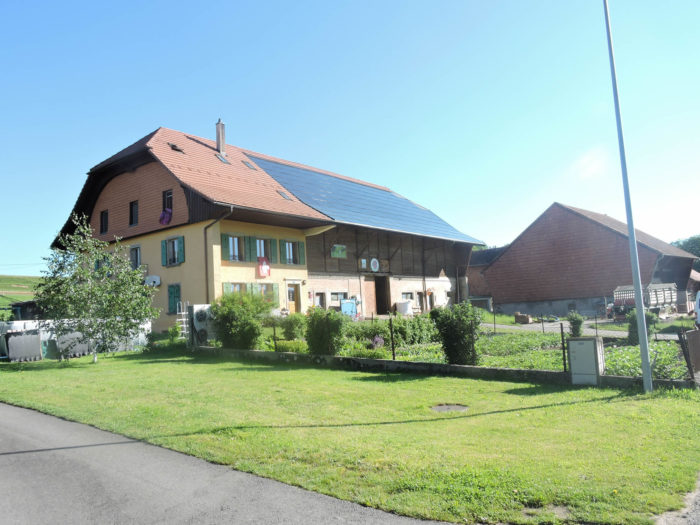 |
Proudly standing by the roadside is an iron cross, erected on a stone pillar, symbolizing a faith rooted in the very earth where it rises.
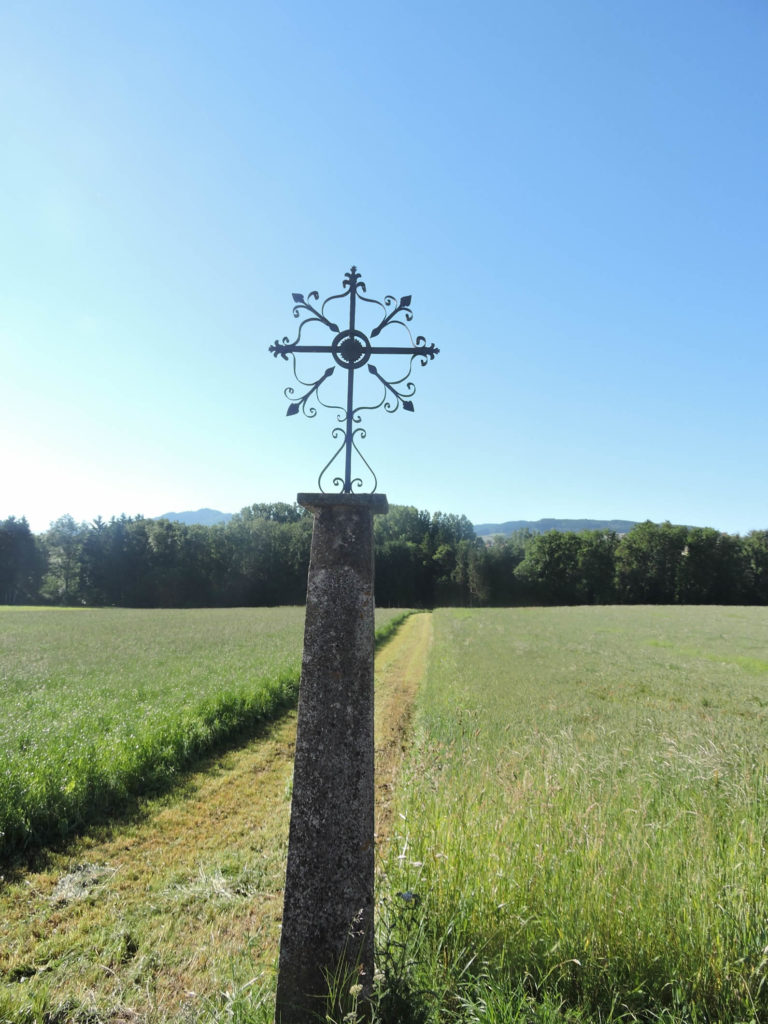
| Further on, the Via Jacobi transforms, taking a narrow road to the left that meanders like a thread of gold through the countryside carpeted with green pastures and golden wheat. In the distance, the Neirigue brook continues its peaceful course through the neighboring woodland, offering a gentle symphony to those who lend an ear. |
 |
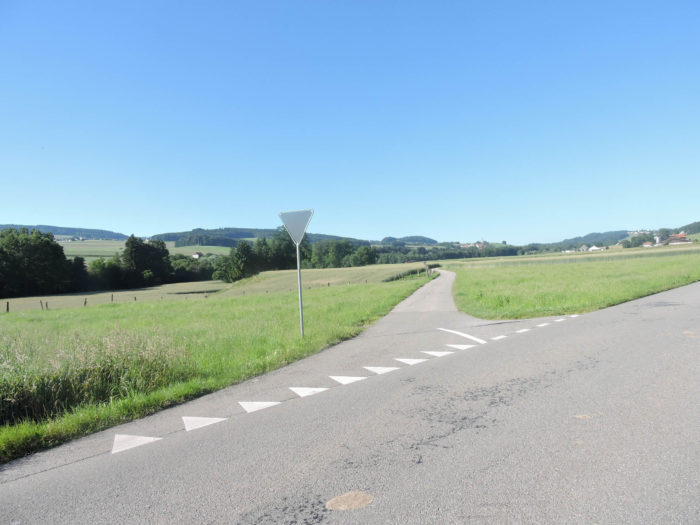 |
| The narrow road skirts the meadows. On your left, the river still flows through the forest. Here, you are facing the Gibloux antenna on the hill, your compass for this stage’s end. And the road stretches on, seemingly endless. |
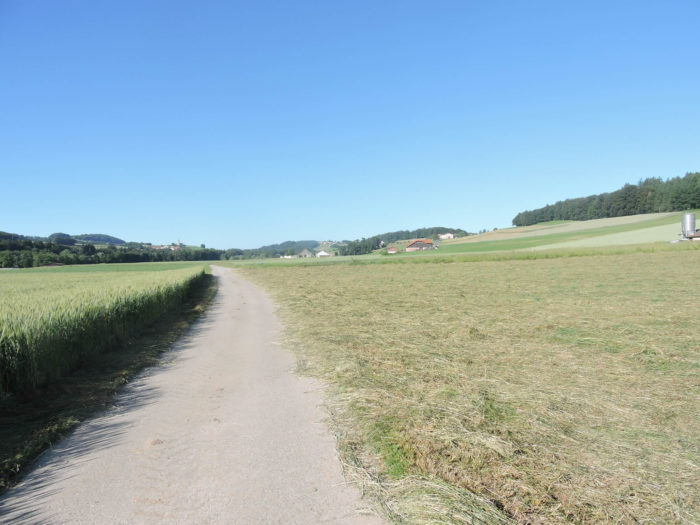 |
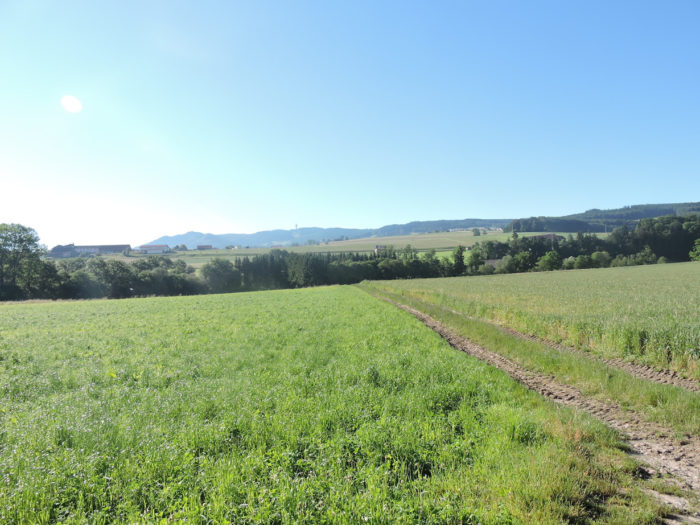 |
Section 6: In the meadows, wheats and corns along the farms.

Overview of the route’s difficulties: a straightforward route.
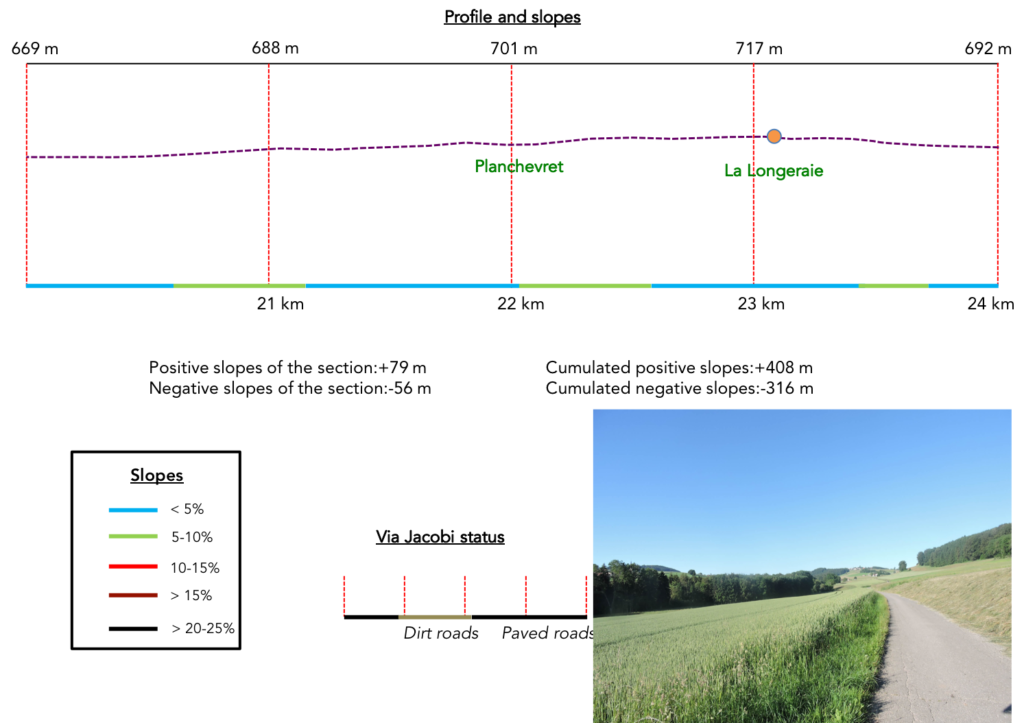
| As it winds its way, the Via Jacobi now bypasses the modest hamlets to only skirt scattered residences here and there, amidst fields and isolated farms. Initially, it intersects the road leading to Fuyens, draped on the hillside with fertile land. |
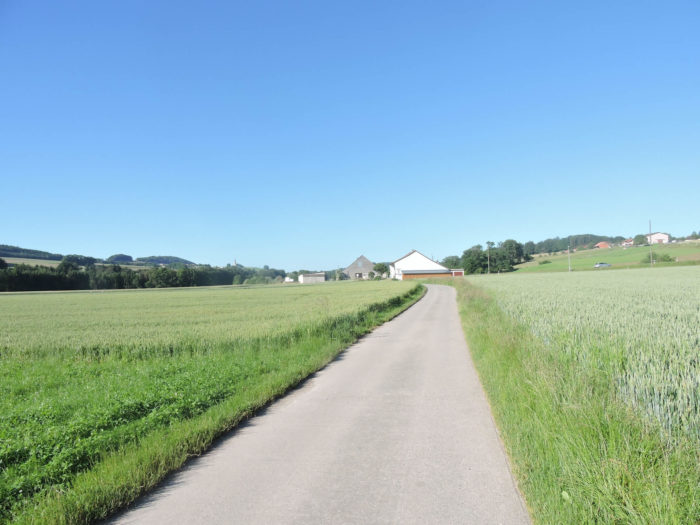 |
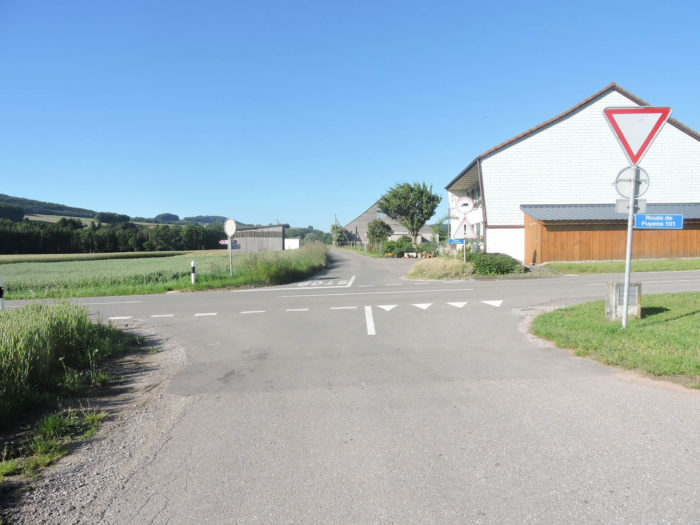 |
The land is rich here, where vast expanses of cereal crops thrive, primarily wheat, a precious rarity in the canton.
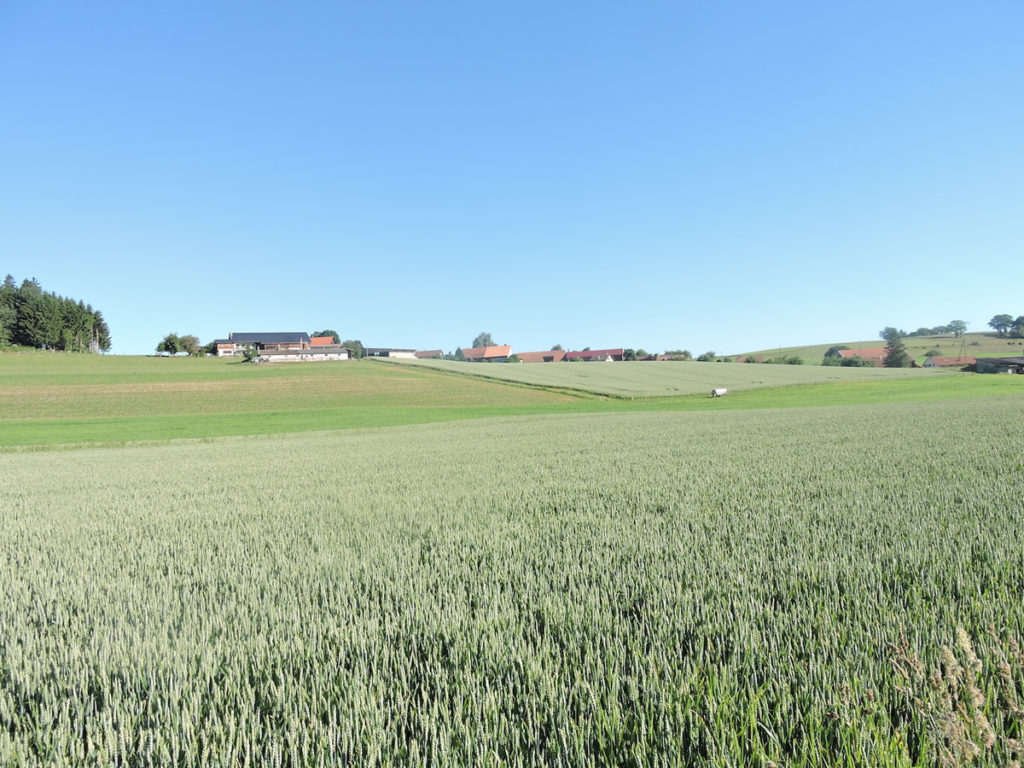
| Continuing its journey through the meadows, it later intersects a more imposing road leading to Massonens, also perched on the hill, above Neirigue, lost in the forest foliage. |
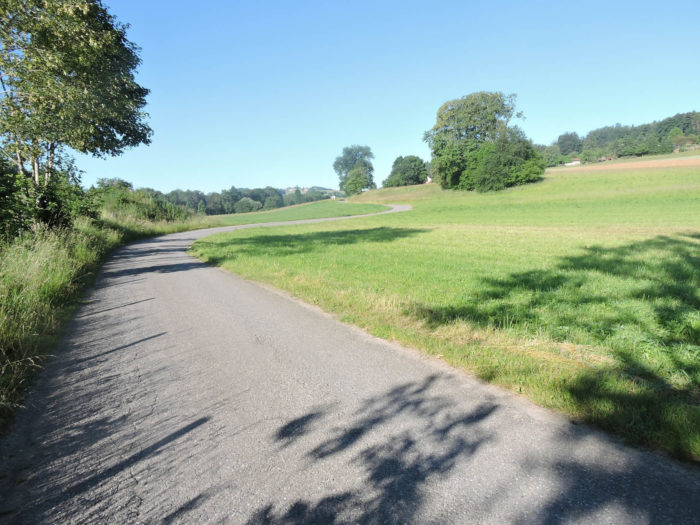 |
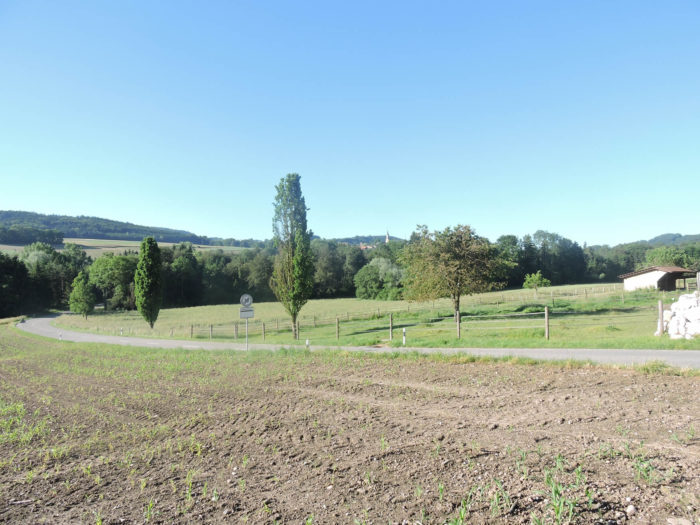 |
| Further on, the Via Jacobi then meanders through the countryside, taking the route of Courts Champs, bordered in parallel by the Neirigue. Here lies a splendid open countryside, inviting for lovers of vast expanses, lush pastures, and endless cornfields, promising a serene and rewarding walk. However, some might tire of the peaceful repetition of these linear landscapes, stretched out for kilometers, finding a monotony that weighs on the soul. For pilgrims crossing Switzerland on the way to Santiago, this stage represents a taste of the Meseta, the vast cultivated and arid plain that stretches for nearly 300 kilometers in Spain. |
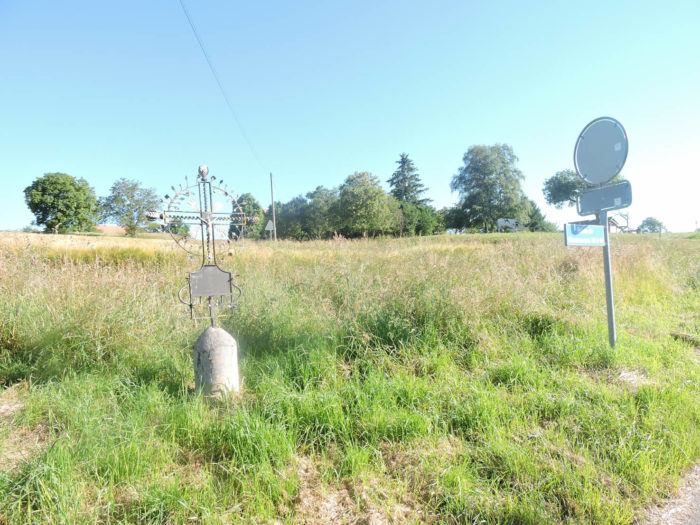 |
 |
| Further on, the road reaches the place called Planchevret, where a fork allows crossing the river to also climb towards Massonens, whose modest church can be seen throughout this endless journey. One almost feels like climbing up there, to change one’s mood. |
 |
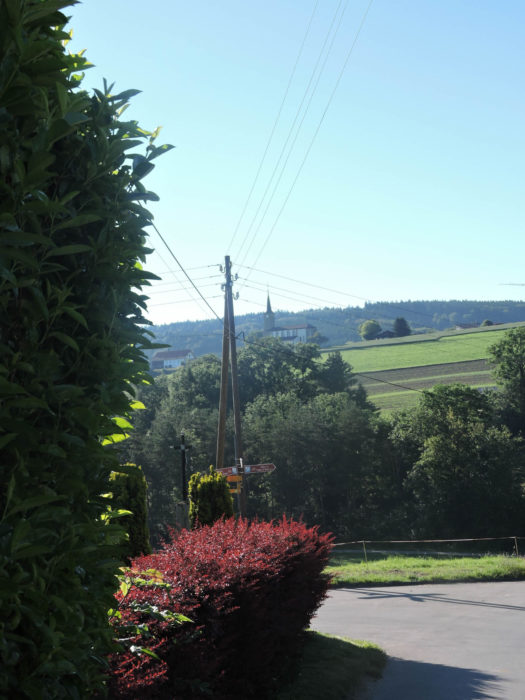 |
| Subsequently, the road descends into the Longeraie Road, winding between meadows and the rare farms scattered in the Longeraie. Here, the countryside opens without restraint, devoid of the protective shade of trees, offering wandering eyes the vast panorama of the plains. Many pilgrims may then feel boredom creeping in during these long traverses of lands where time seems to stretch endlessly, punctuated only by the curious and amused glances of cows, always wondering about these strange bipeds carrying a bag on their backs. |
 |
 |
| The slope is gentle here. A little further down, the road crosses one of the many tributaries of the Glâne River. |
 |
 |
Around the bend in the road, the city of Romont is soon visible perched on the hill, like a glimmer of hope, offering solace to those in need of courage.

Section 7: Romont on the horizon.
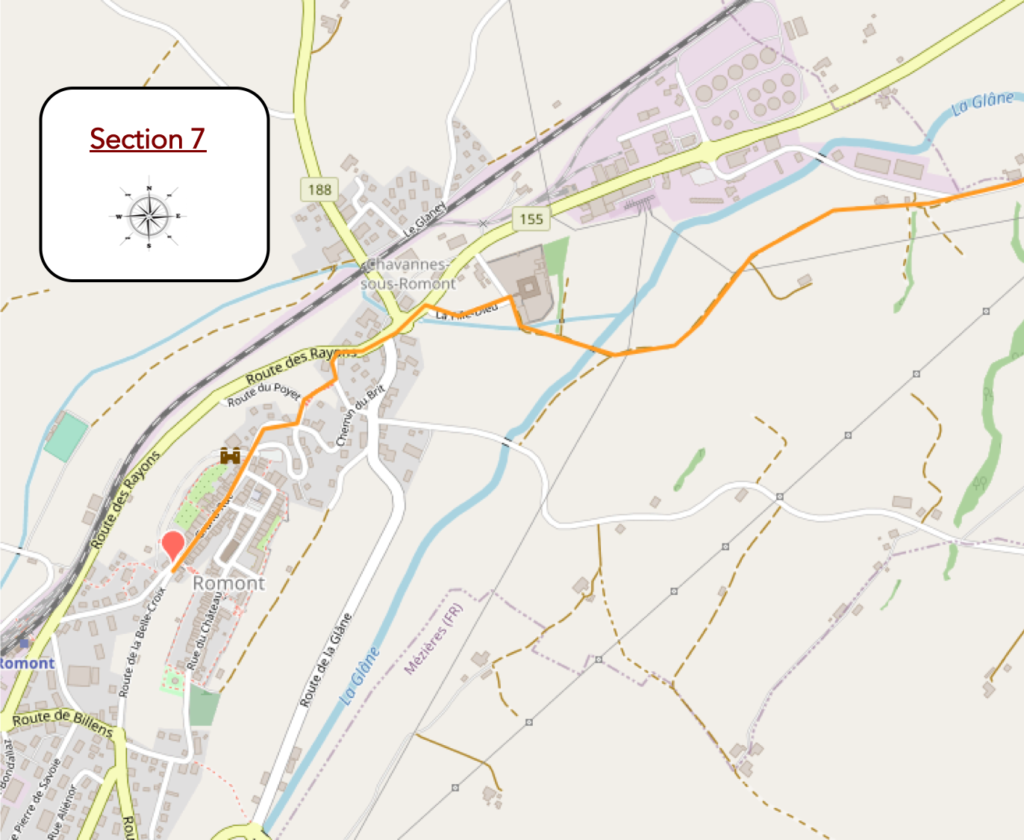
Overview of the route’s challenges: a straightforward path with a noticeable incline towards the city.

| The road, winding like a serpent, gently slopes, offering one last glimpse of the beautiful city on the near horizon. |
 |
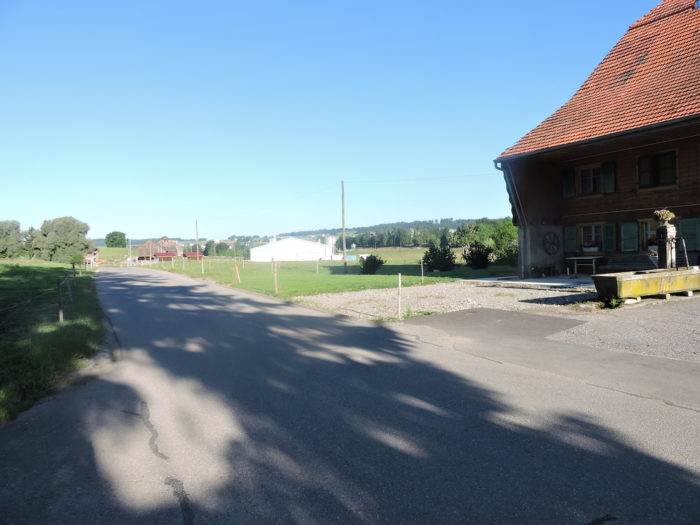 |
| A venerable Fribourg farmhouse proudly stands at the roadside, a silent witness to the passage of time, as the road, like an insatiable stream, continues its journey towards Romont’s sports center. |
 |
 |
| In a tranquil dance with the landscapes, the road undulates through fields, granting the eager eye a final caress of the surrounding countryside before disappearing into the winding path of dirt. There, nestled in the peaceful enclave of the woodland, lies the convent of La Fille-Dieu, like a hidden treasure within nature’s folds. |
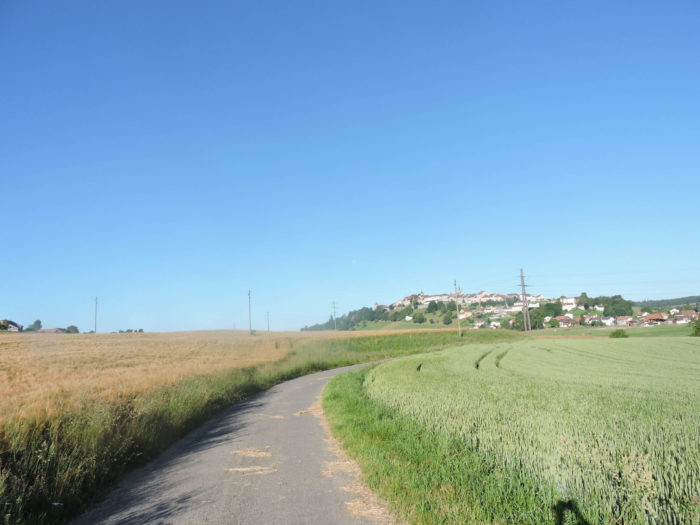 |
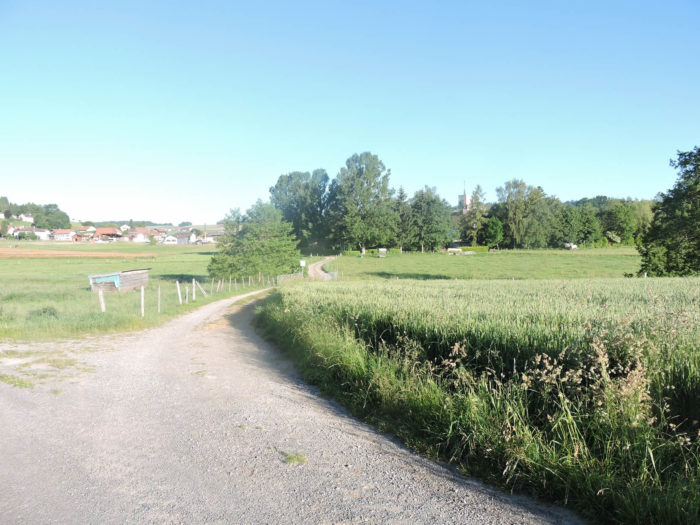 |
| At this juncture, the path delicately crosses the Glâne, a slender stream murmuring its secrets, while another brook, named Glaney, joins its melody. These lands, bathed in these benevolent waters, are often referred to as the Glânes, in a landscape that undoubtedly once was marshland. |
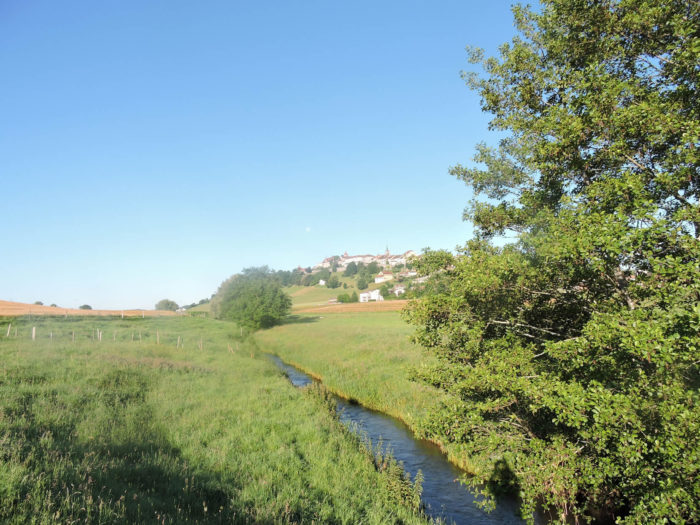 |
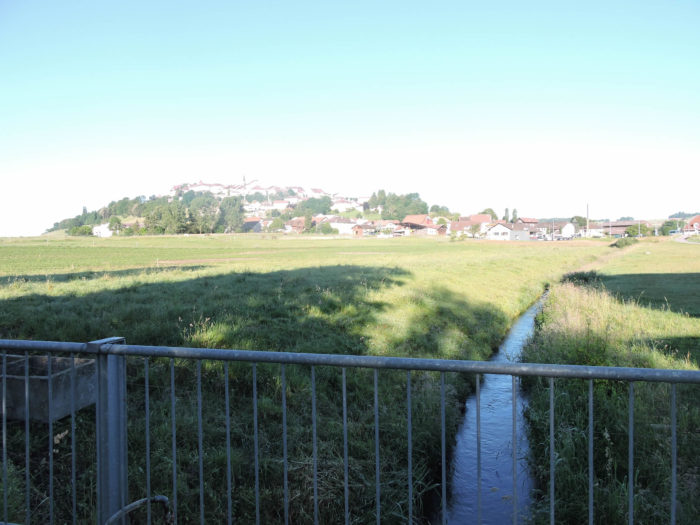 |
| The route then unfolds before the imposing walls of La Fille-Dieu, the millennial abbey which, since the 12th century, has housed devoted Trappist Cistercian sisters dedicated to contemplation. These walls steeped in history, renovated with a delicacy befitting ancient craftsmen, welcome pilgrims, offering refuge to those bearing the credencial, the pilgrim’s passport to Santiago. |
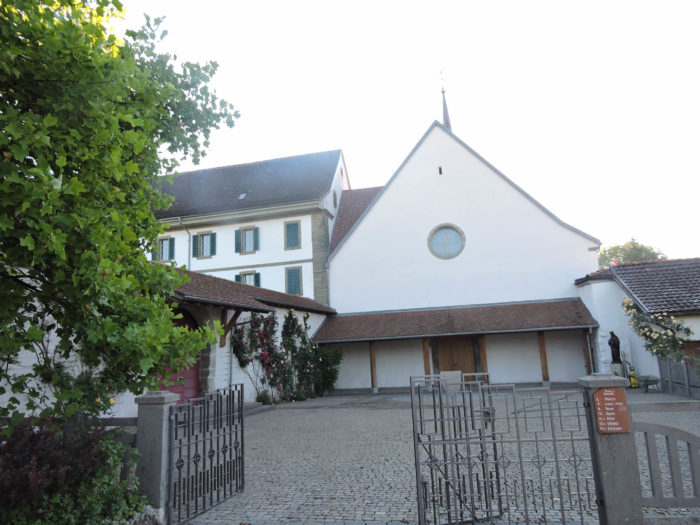 |
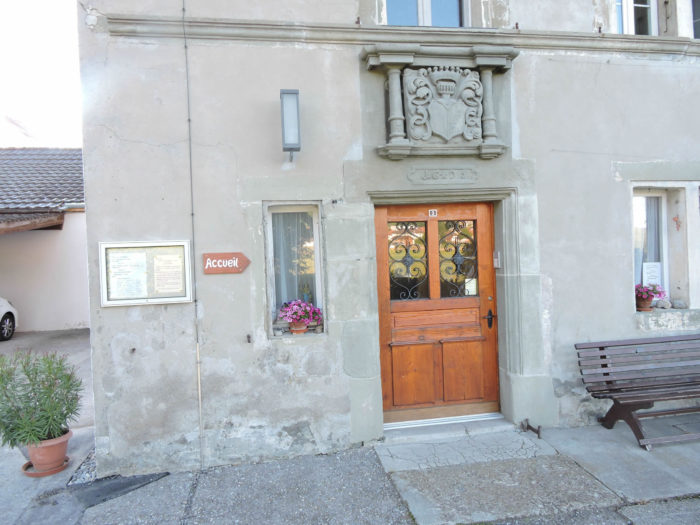 |
| After a final nod to the Glaney, the modest road strides towards a roundabout, thus announcing the entry into the city’s ramparts. |
 |
 |
| Beneath the benevolent gaze of the heavens, the Via Jacobi ascends the steep heights of the city, following the Brits trail like a determined pilgrim striving for the summit of faith. |
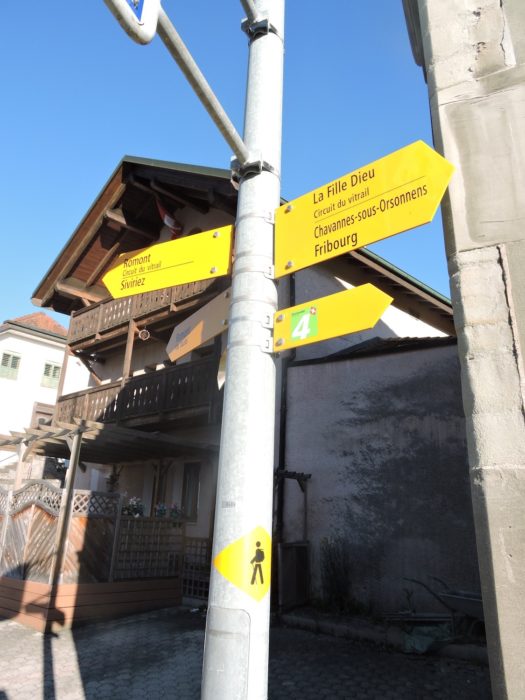 |
 |
The heart of the city, perched atop the heights, welcomes the Via Jacobi. And there, proudly emerging on the horizon, stands the Tower of Fribourg, also known as the Lussy Gate. This stone sentinel, hewn from the molasse of ages, preserves the memories of an era when cannon fire marked the city’s hours. Defying time, it survived the disappearance of gates that once impeded free passage.
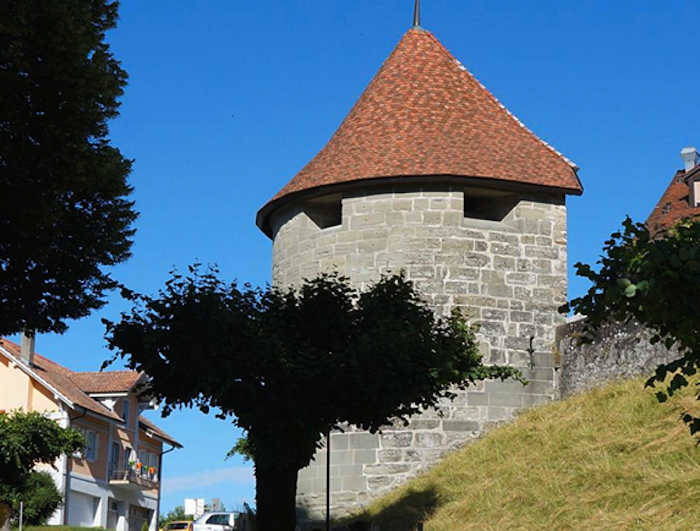
| Thus, at the pinnacle of this ascent, the Via Jacobi is privileged to gaze upon the vibrant heart of Romont, a peaceful city populated by 5500 souls, where history intertwines with modernity in a harmonious symphony. |
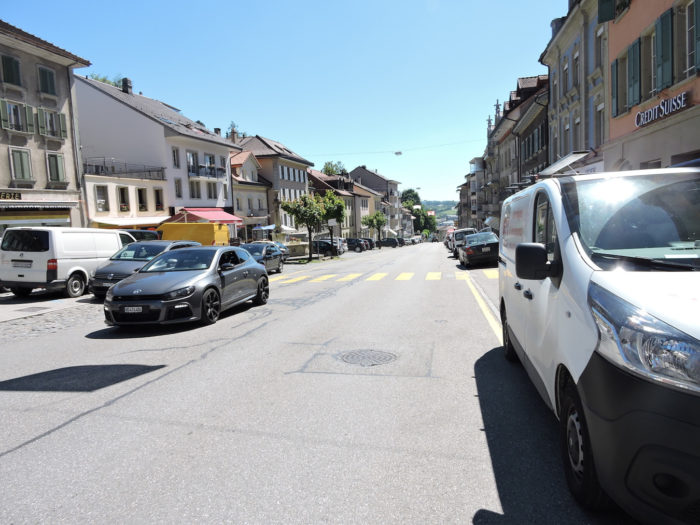 |
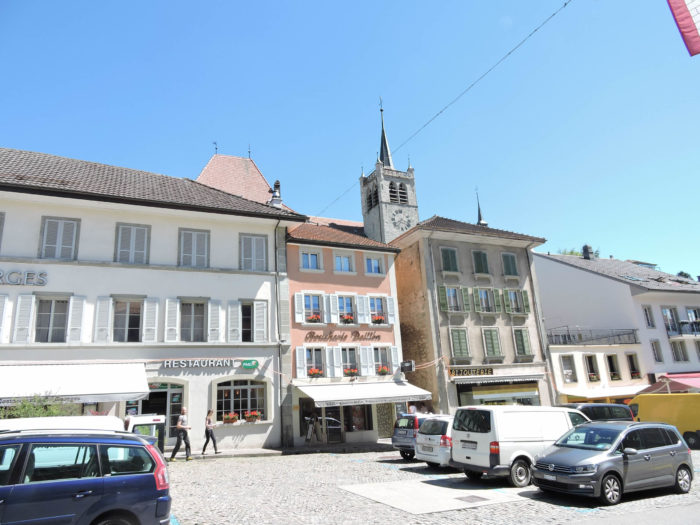 |
Section 8: Brief visit of Romont.
In the ancient stone setting of Romont, a medieval city of unparalleled elegance, lies a historical wealth inviting discovery. Its cobbled streets, steeped in centuries of history, are the stage for enchanting strolls, offering visitors a plunge into the epic of time. There are beautiful walks to be had along the ramparts.

| The majestic ramparts, like age-old sentinels, stretch from the Tower of Fribourg to the Tower of Billens, revealing a breathtaking panorama of the surrounding valley. |
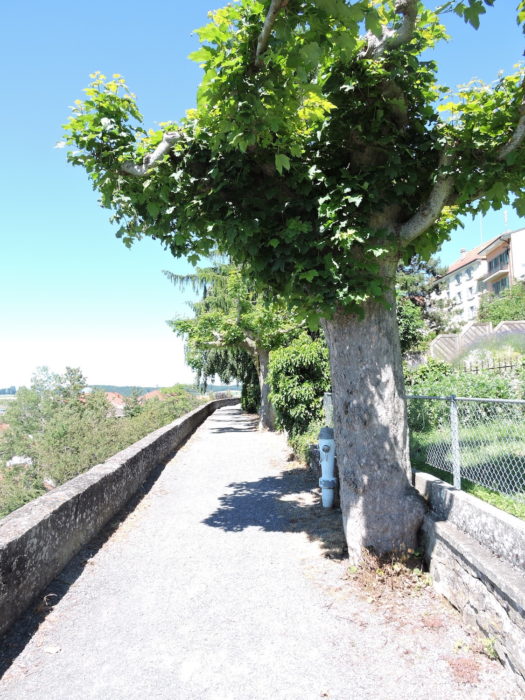 |
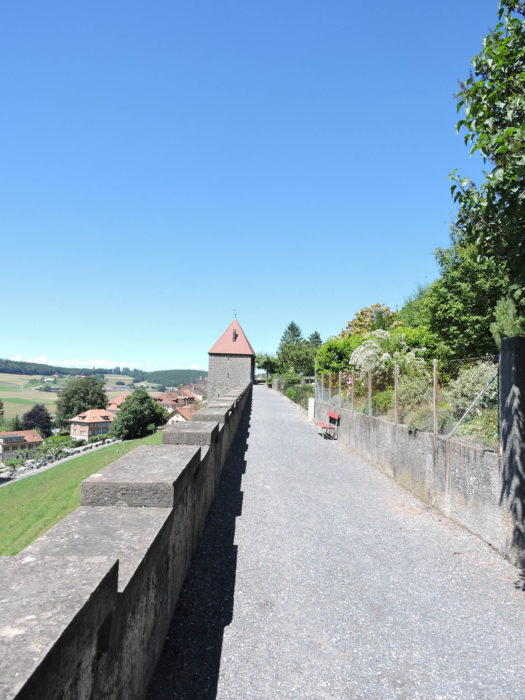 |
| Romont, keeper of legends, unveils its secrets along the battlement paths, where charming ancient dwellings nestle, their hanging gardens evoking oases of greenery above the world. |
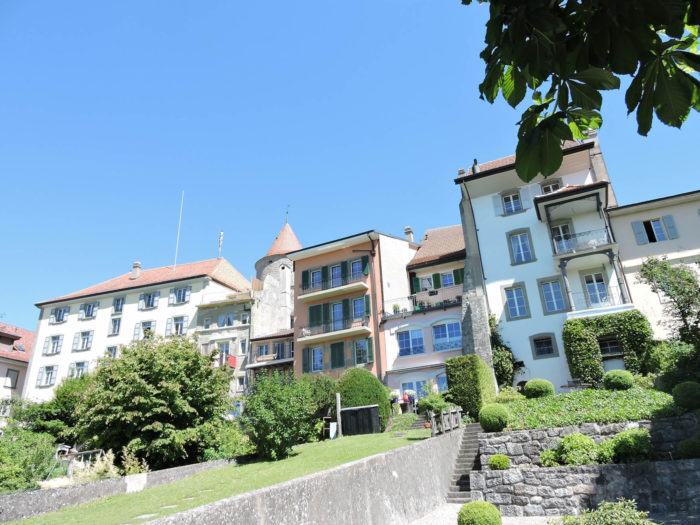 |
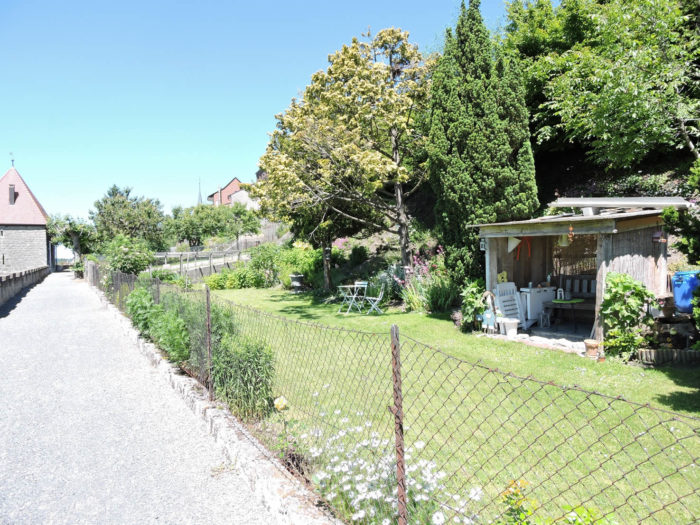 |
Below, the muffled murmur of trains at the station contrasts with the medieval atmosphere reigning supreme over the city.
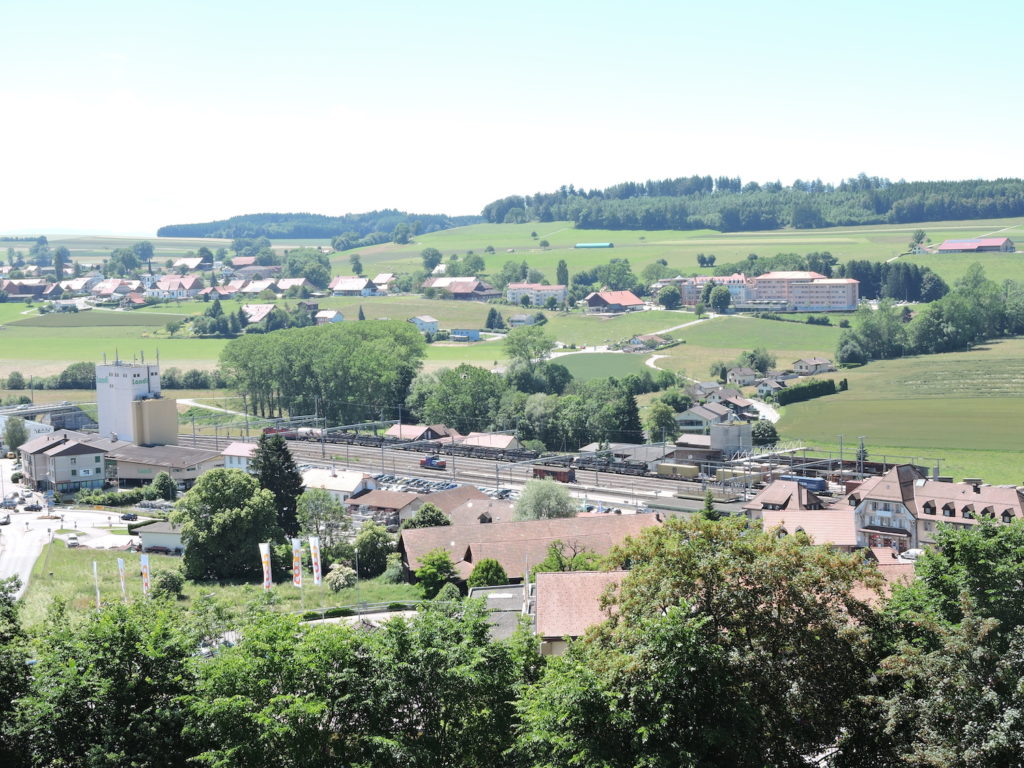
| There are still other small towers scattered throughout the city, like the Tower of Sauvage, now a cultural space hosting artist exhibition. One must head west to find the large Boyer Tower. Formerly known as the “Little Keep,” Boyer Tower, to the west, was built in the 13th century. It stands 38 meters high but is not directly connected to the ramparts. Originally, it was a complete castle with enclosure and living quarters. During the last centuries, it mainly served as a water tower. |
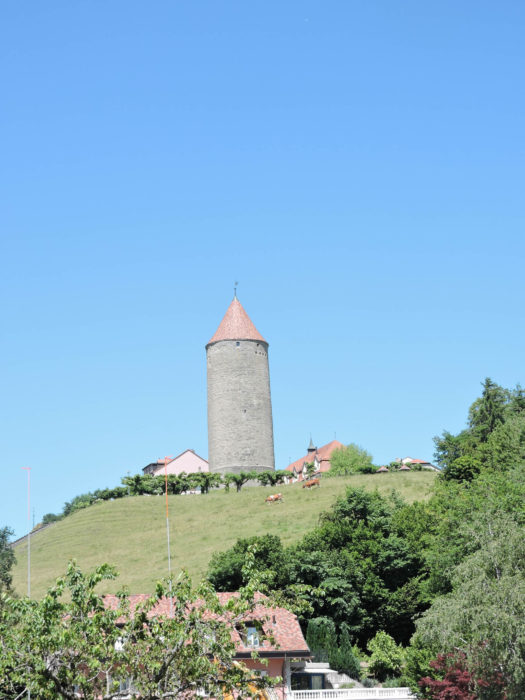 |
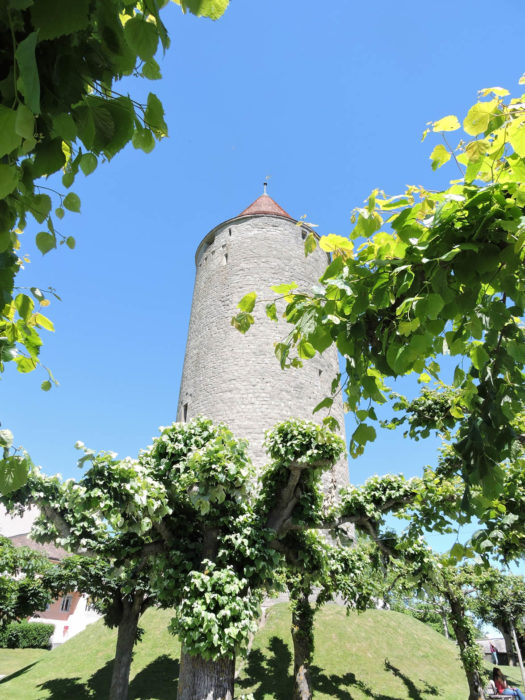 |
| But the heart of Romont beats to the rhythm of its imposing castle, a true jewel of medieval history. In the shadow of its ramparts, a verdant courtyard opens to visitors, bearing witness to past splendors where a drawbridge once crossed the moat, now silent witnesses to the passing of time. |
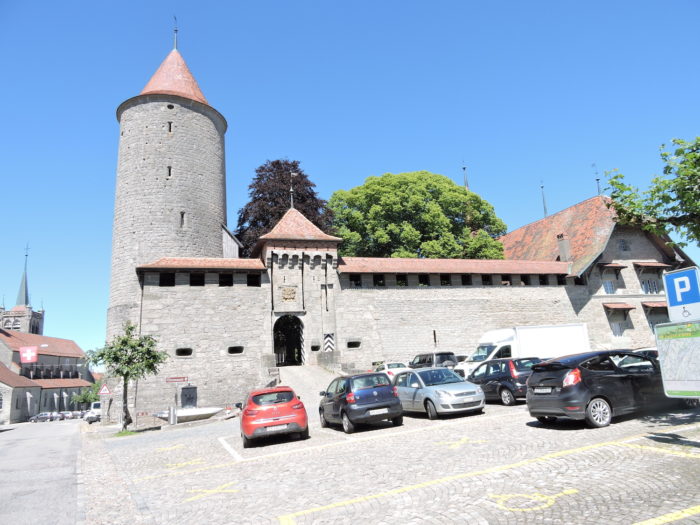 |
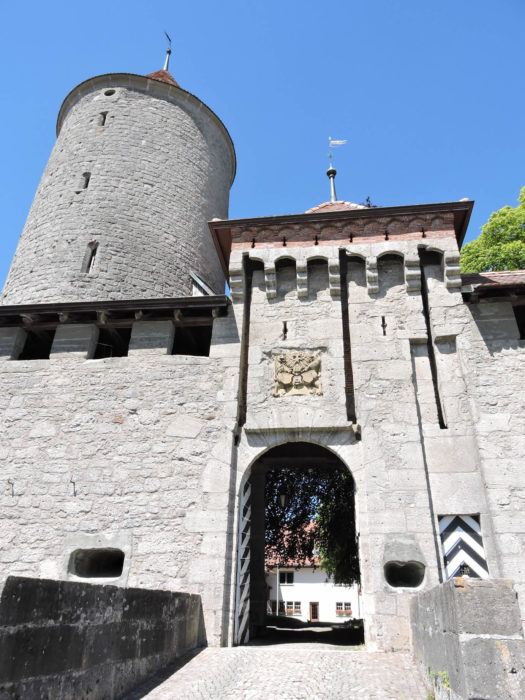 |
| In the inner courtyard, a centuries-old well, 36 meters deep, stands majestically, its wooden wheel evoking ancient times when water meant life and survival. |
 |
 |
| The castle, nowadays, not only houses part of the city’s administration but also the prestigious Swiss Stained Glass and Glass Arts Museum. Its sumptuous halls harbor unique treasures, from ancient stained glass to contemporary creations, showcasing the ingenuity and talent of artisans through the ages. |
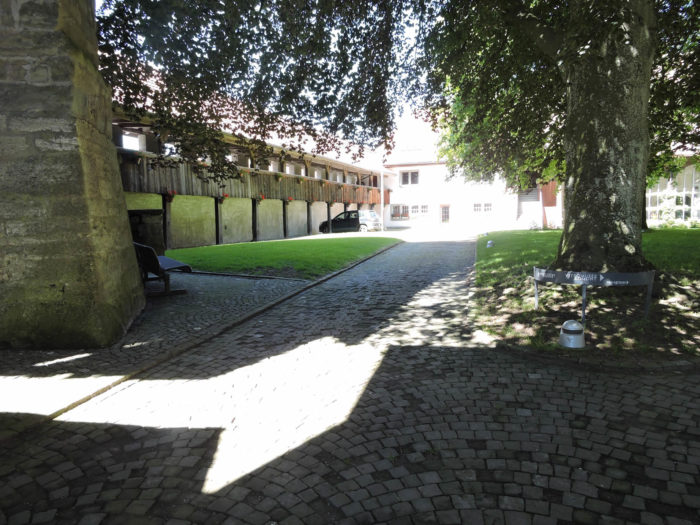 |
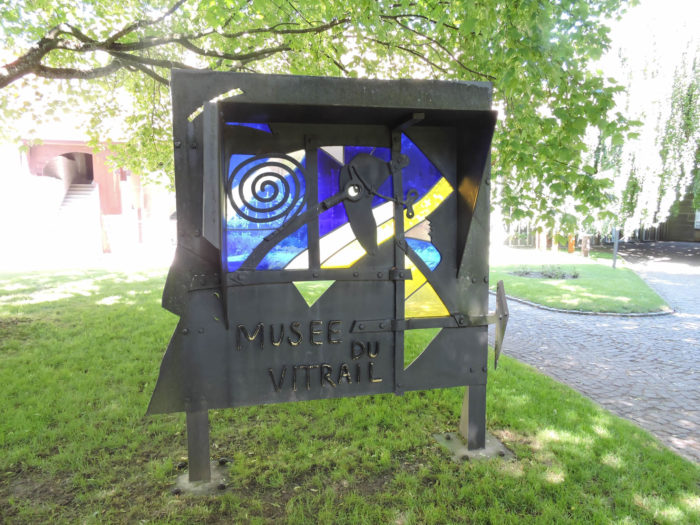 |
| At the corner of Châteaux Street stands the majestic Collegiate Church of Our Lady of the Assumption, whose slender silhouette pierces the sky like a spiritual beacon. Recently restored, this 13th-century Gothic church celebrates the grandeur of sacred art, its ancestral stained glass illuminating the space with divine light. Here resides the soul of Romont, where the Stained-Glass Museum echoes the magnificence of centuries past. |
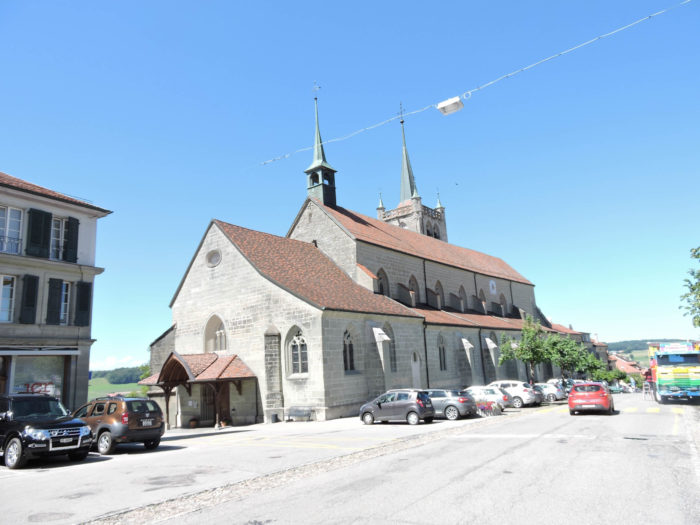 |
 |
Lodging on Via Jacobi
- Rose Chervet, La Maison des Anges, Froideville; 026 400 06 51/079 519 21 49; Guestroom, breakfast
- Marie-Claude Chatton, Route de Matran 47, Hauterive; 079 692 41 76; Accueil jacquaire, dinner, breakfast
- La Croix Blanche, Route de Fribourg 71, Hauterive; 026 411 99 00; Hotel, dinner, breakfast
- Roger Galley, Long Praz 11, Ecuvillens; 026 411 10 23/079 230 70 48; Gîte (straw), breakfast
- Marie-Claude Etegny, Ch. des Granges 14, Ecuvillens; 026 430 00 28/078 664 42 46; Accueil jacquaire, breakfast
- Anne-Marie Cruchaud, Chemin des Granges 110, Ecuvillens; 079 689 44 41; Guestroom, breakfast
- Aux 4 éléments, Route de Chénens 2, Autigny; 026 477 07 26/079 308 27 29; Guestroom, breakfast
- Claudine Berset, Impasse du Félon 7, Autigny; 026 477 23 03/079 543 78 55; Guestroom, breakfast
- Marie-Rose Schneider, St Garin 21, Autigny; 026 477 12 82/079 709 58 83; Guestroom, breakfast
- Lucien et Dominique Haller, Route de Chénens 2, Autigny; 079 308 27 29; Guestroom, breakfast
- Hôtel Restaurant de l’Ecu, Au Village 43, Autigny; 026 477 11 26; Hotel, dinner, breakfast
- Pavillon Paisible, Route de Massonens 40, Orsonnens; Guestroom, breakfast
- Monastère Notre-Dame de Fatma, Route de Massonens 7, Orsonnens; Accueil chrétien, dinner, breakfast
- Abbaye de la Fille Dieu, Romont; 026 651 90 10; Accueil chrétien
- Daniel Zimmermann, Chemin de la Maula 27, Romont; 026 652 22 24; Accueil jacquaire, breakfast
- B&B Demierre, Grand Rue 44, Romont; 026 652 14 73/079 329 87 52; Guestroom, breakfast
- Anne et Daniel Stern, La Maladaire 9, Romont; 026 652 40 01/079 423 20 02; Guestroom, breakfast
- Carole et Pascal Richoz, Chemin du Brit 9, Romont; 079 509 57 34; Guestroom, breakfast
- Hôtel du Lion d’Or, Grand Rue 38, Romont; 026 652 22 96; Hotel, dinner, breakfast
- Hôtel St Georges, Grand Rue 31, Romont; 026 652 44 10; Hotel, dinner, breakfast
Finding accommodation on this stage shouldn’t pose major difficulties. You’ll be in cities with all the necessary amenities. However, it’s still wise to make reservations for peace of mind.
Feel free to add comments. This is often how you move up the Google hierarchy, and how more pilgrims will have access to the site.
 Next stage: Stage 16: From Romont to Moudon
Next stage: Stage 16: From Romont to Moudon
|
 |
Back to the menu |























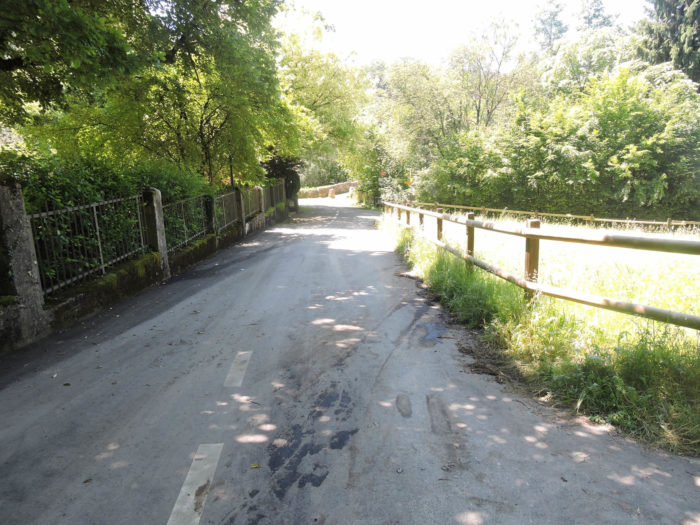



























































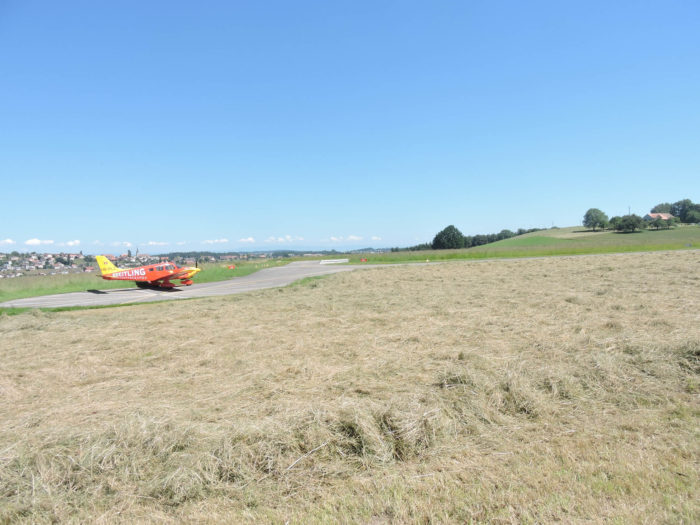
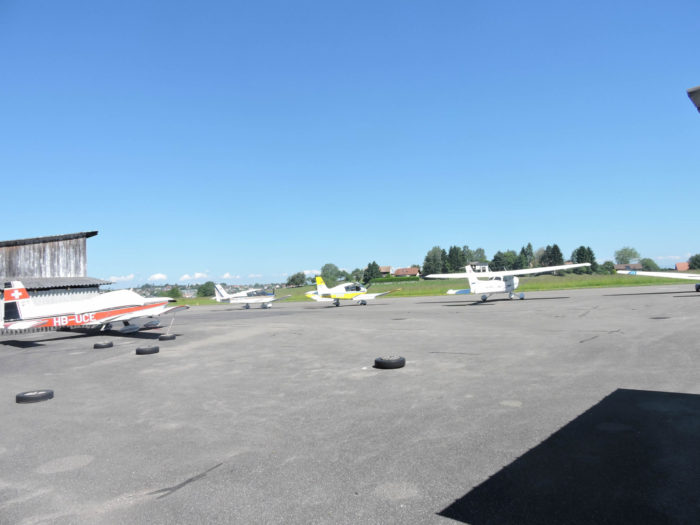






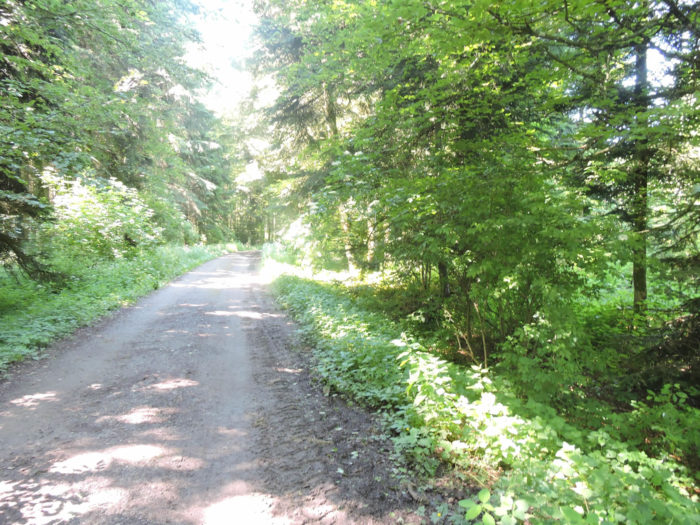
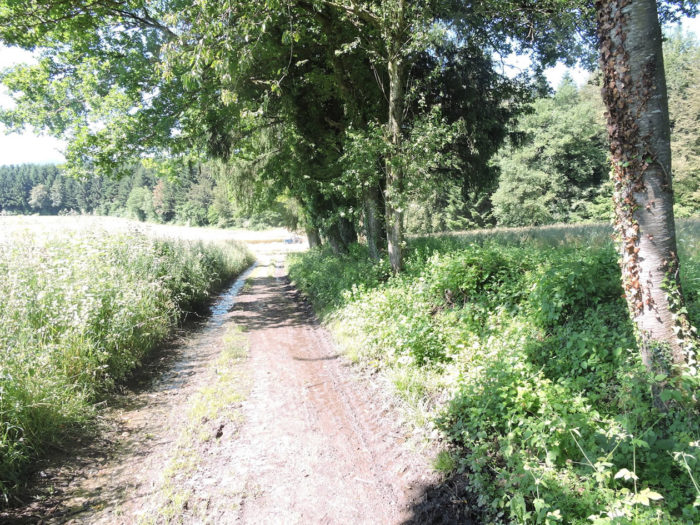














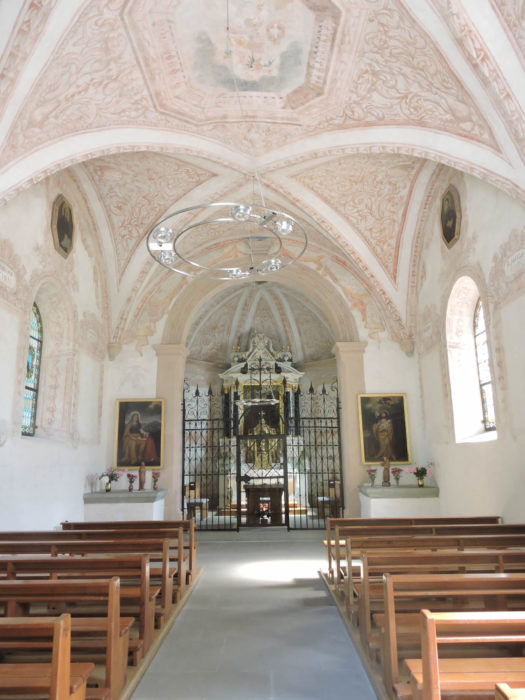

































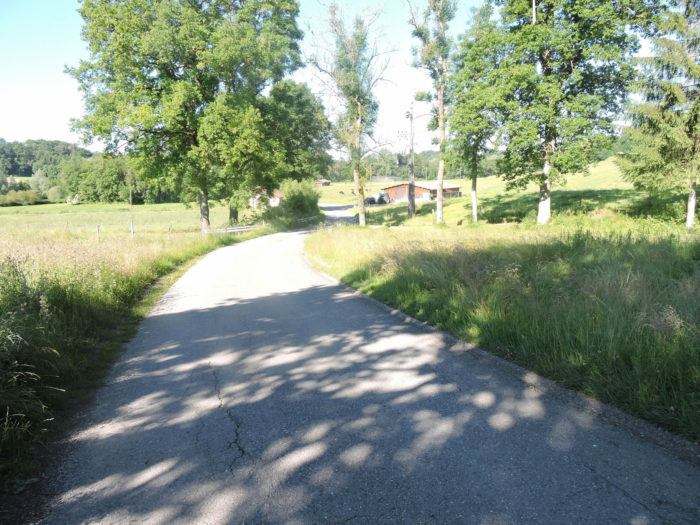







































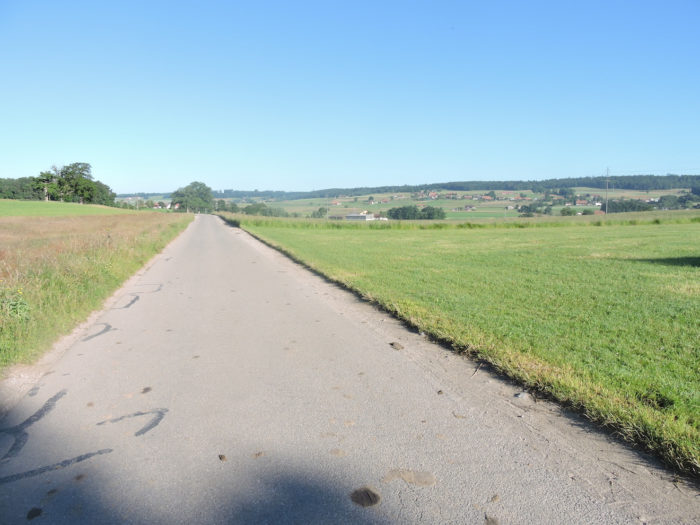



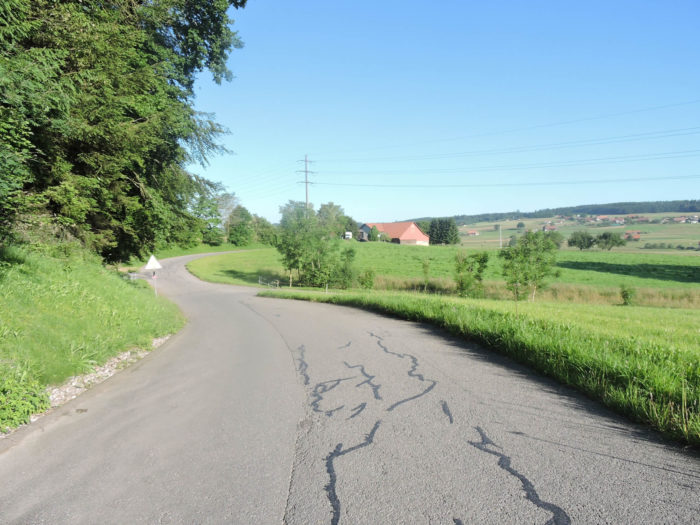
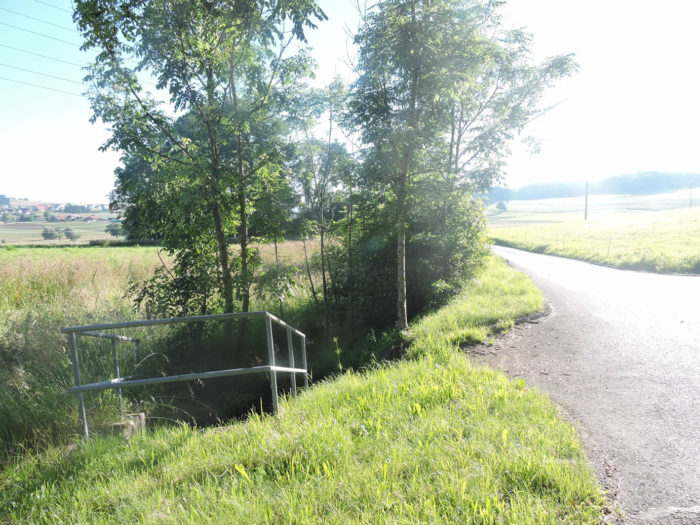


















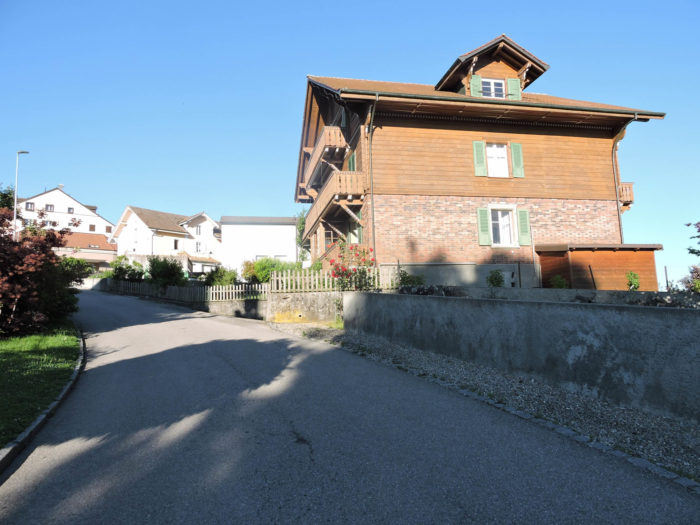























 Next stage: Stage 16: From Romont to Moudon
Next stage: Stage 16: From Romont to Moudon
